Hover your mouse over the image and see the AI genereated caption and rating. Have fun!

AI Summary: To avoid long lines at the main entrance, consider visiting the Carrousel du Louvre, an underground entrance with short wait times (usually 5 minutes) that grants access to the same areas as Le Pyramide. After passing security, spend more time exploring the museum's vast collection of artworks and history.
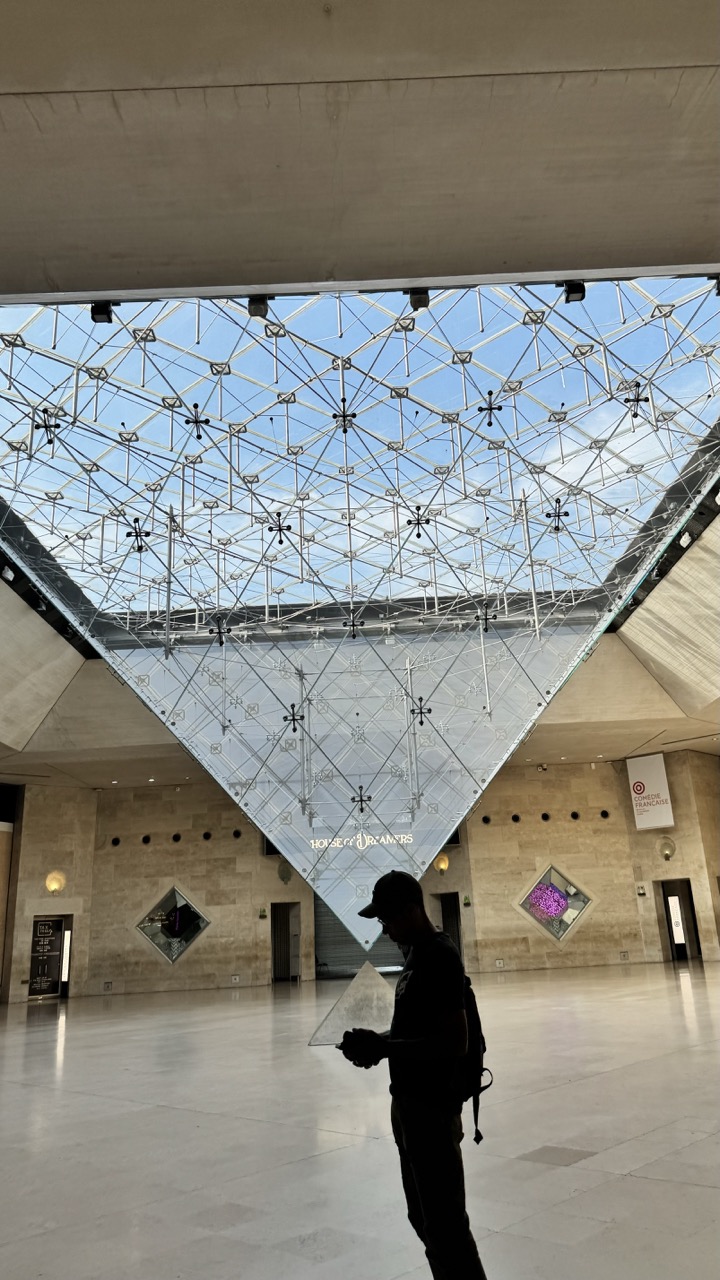

Title: Pyramidception at the Louvre
Rating: 8/10
Ah, the classic scene: an iconic architectural marvel and a lone figure seemingly engaged in a profound study of... something small in their hands. Is it a mini souvenir pyramid, a crucial Louvre map, or perhaps just checking how many steps they've taken? The grand glass pyramid of the Louvre dominates the scene, a geometric masterpiece under a bright sky, while our silhouetted subject adds a touch of human scale and mystery. What's happening is a moment of personal reflection (or distraction) within a vast public space, capturing the juxtaposition of grand scale and individual focus. The mood is architectural and contemplative, slightly alienating due to the silhouette and the sheer emptiness of the space, yet undeniably impressive. It screams "tourist moment," but with a side of high-art backdrop.
From a photographer's standpoint, the high contrast lighting is the star here, expertly creating that strong, graphic silhouette against the bright interior and sky. The composition effectively uses the leading lines of the floor and the dramatic angles of the pyramid to draw the eye upwards and inwards. The placement of the person off-center adds dynamism, preventing the image from being purely symmetrical, and they serve as a vital anchor point against the overwhelming structure. Color is understated, letting the light, shadow, and form do the heavy lifting, with the exception of that intriguing splash of purple in the display on the wall. The critique? Maybe we could've seen the person's face or what they were holding, adding more narrative, but then we wouldn't have this striking silhouette playing hide-and-seek with the light. It's a solid capture of a well-known location, proving sometimes the best light is the light you get, and silhouettes can be surprisingly compelling.
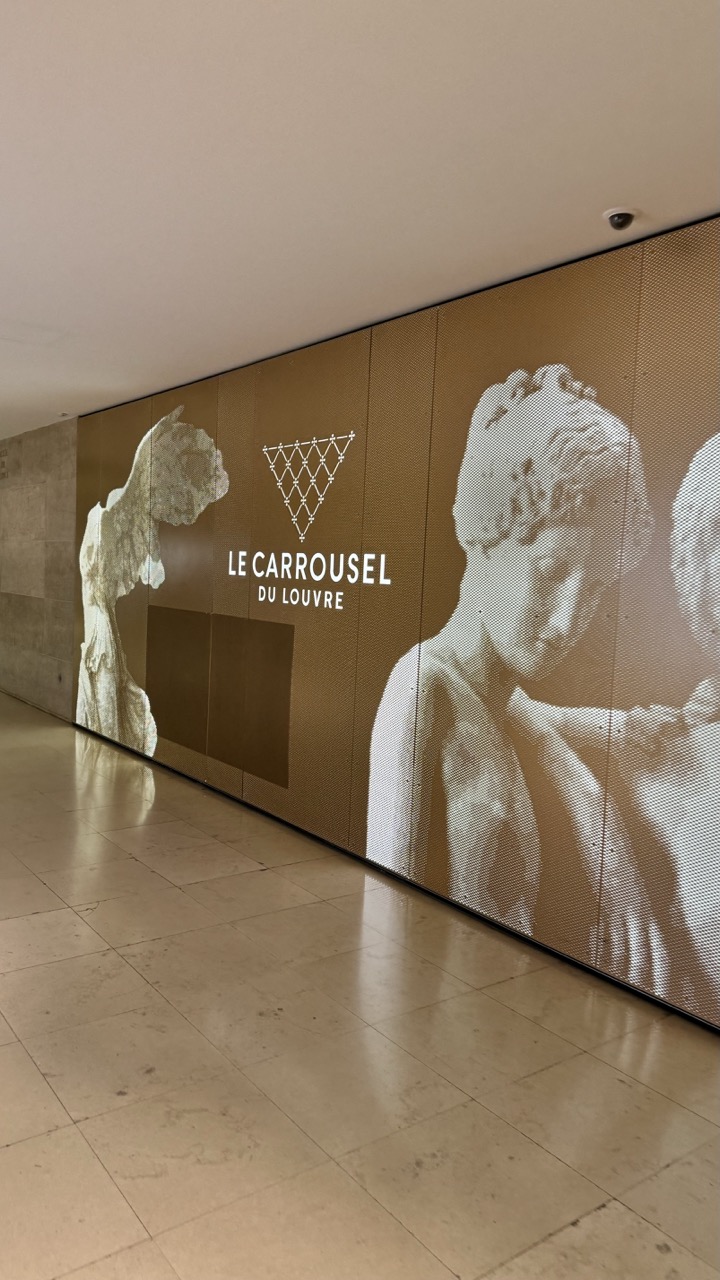

Pixelated Past in a Posh Passage
Rating: 7/10
This image captures a visually striking wall display within what is clearly a modern, high-end interior space – specifically, the Carrousel du Louvre. The subject matter is a clever fusion of ancient classical sculpture rendered in a contemporary dot-matrix style, showcasing iconic pieces like the Winged Victory of Samothrace on the left and a grouping of figures on the right, all set against a rich, textured gold background. The large white text prominently advertises "LE CARROUSEL DU LOUVRE" below a stylized geometric logo reminiscent of the Louvre Pyramid structure. The mood is one of sophisticated artistic promotion, blending the grandeur of the museum's collection with a sleek, modern aesthetic to entice visitors into the adjacent retail and exhibition space. It's a static scene, designed for passersby to absorb as they navigate the gleaming hallways.
From a photographic perspective, the composition is a straightforward, slightly low-angle view down the long wall display, utilizing the natural perspective of the corridor to emphasize its length. The lighting appears to be standard interior illumination, effectively lighting the display itself and creating pleasing reflections on the polished, large-format floor tiles which add a touch of visual dynamism. The color palette is dominated by warm golds, beiges, and whites, creating a clean and slightly opulent feel. While the angle is functional, a more creative approach might have incorporated human elements or a different perspective to make the image more engaging. However, as a documentary shot of the installation, it's clear and effective, even capturing the ubiquitous security camera perched on the ceiling, ensuring everyone appreciates the pixel art correctly – or else!
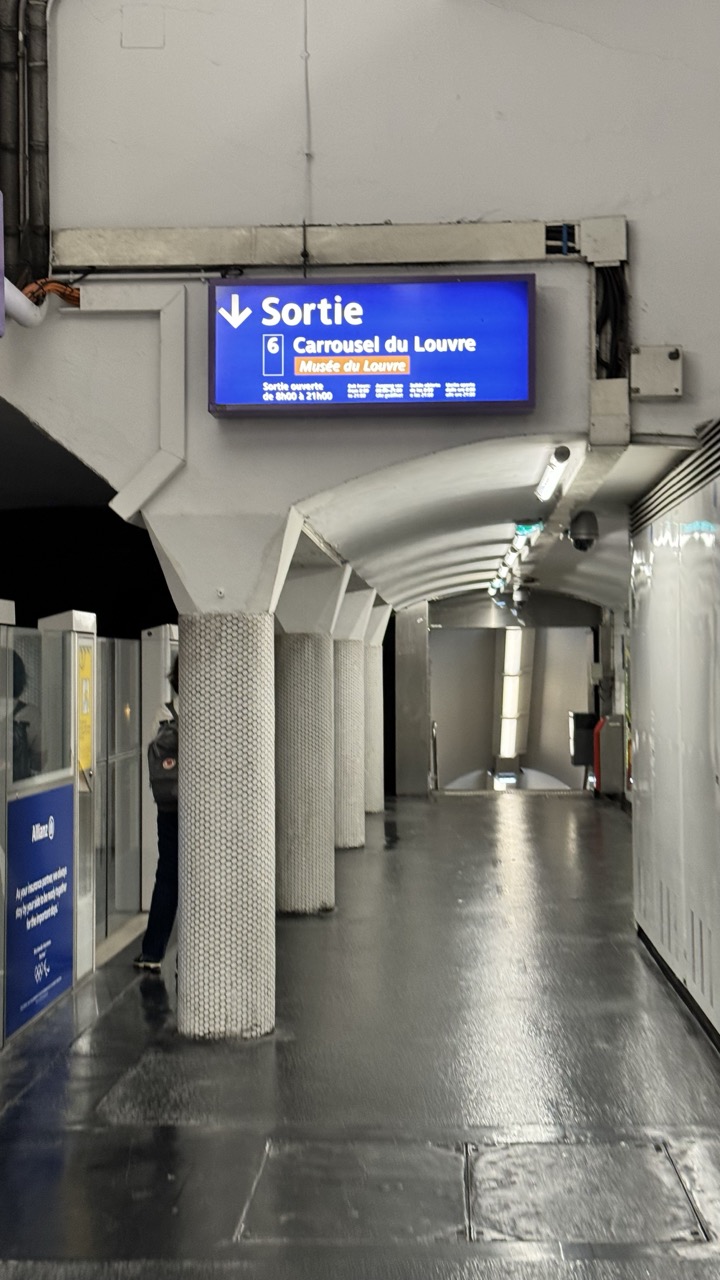

Urban Transit Ballet
Rating: 7/10
This shot captures a moment of urban transit, specifically highlighting an exit towards the famous Carrousel du Louvre and Musée du Louvre from what appears to be a Parisian metro station. The main subject is the functional architecture of the passageway, dominated by the repeating, tiled pillars and the bright, directional blue exit sign. We see a solitary figure standing near a barrier on the left, adding a human scale to the otherwise impersonal environment and suggesting the action of exiting the station. The mood is distinctly utilitarian and cool, typical of underground public spaces, with the stark blue sign offering a pop of color and clear purpose within the grey and white surroundings. Pertinent objects include the prominent exit sign (indicating exit 6 and destinations), the textured pillars, the highly reflective floor, barrier gates, and an advertisement panel on the left. The background shows the continuation of the arched hallway receding into the distance under artificial lighting.
From a photographic perspective, the composition utilizes the strong vertical lines of the pillars to create rhythm and depth, guiding the viewer's eye into the scene. The bright blue of the exit sign provides a clear focal point against the muted palette, its intense illumination contrasting with the softer light in the rest of the tunnel. The lighting, primarily artificial and overhead, casts reflections on the floor, which add a layer of visual interest and complexity, albeit making the floor look perilously slick – perhaps the real challenge isn't finding the exit, but staying upright on the way there! The style leans towards documentary photography, capturing an everyday scene candidly. The reflective floor is a key element, making the ground itself a dynamic surface that mirrors the overhead lights and forms. It’s a study in lines, light, and the purposeful design of public movement, subtly critiquing the lack of warmth but appreciating the clarity it offers amidst the potential confusion of a large transit hub.
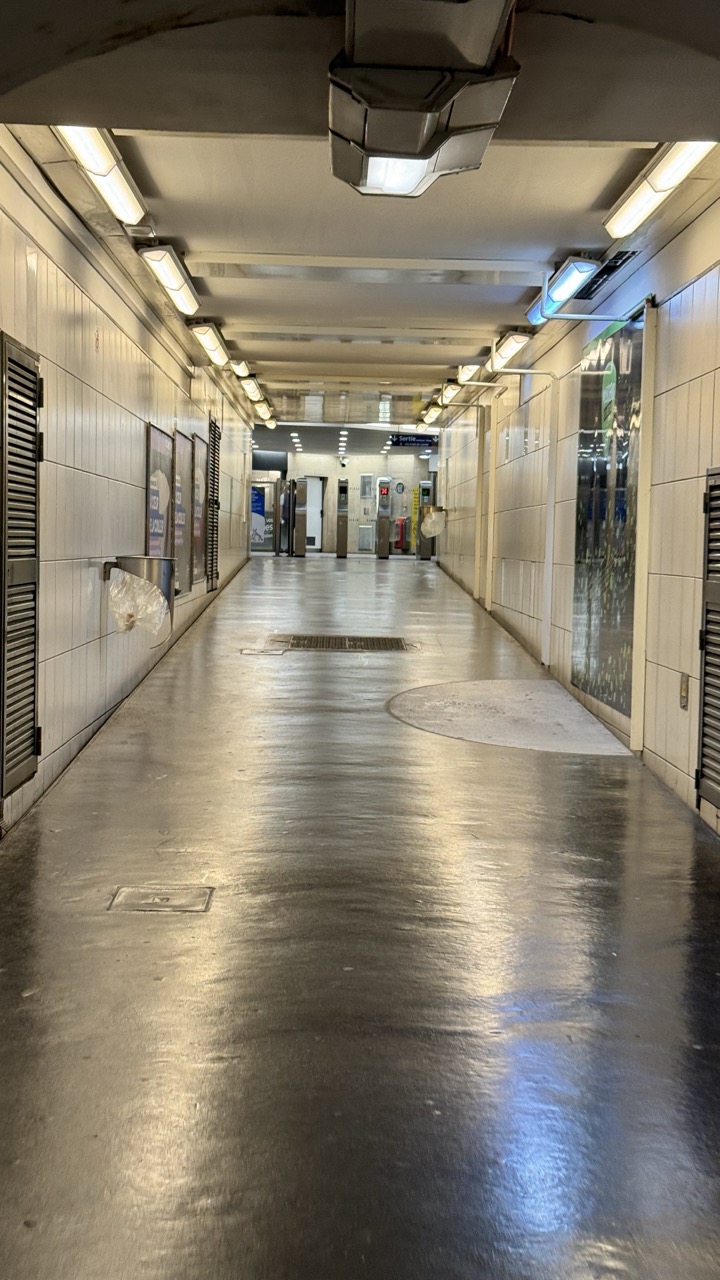

The Existential Dread of the Empty Corridor
Rating: 6/10
Welcome to... well, it's a corridor. Specifically, a very long, very empty corridor that looks suspiciously like a forgotten level in a video game where you know something is about to jump out at you. What's happening? Absolutely nothing, which is precisely the point. The mood is less "bustling transport hub" and more "where did everyone go?". It's stark, utilitarian, and boasts a polished floor that clearly just got the five-star cleaning treatment, probably moments before you arrived, hence the eerie silence. Look, there's even a little trash bin with a sad, puffy plastic bag, probably holding the last remnants of human activity, like a half-eaten croissant or a discarded transit ticket. The background dissolves into a distant area with turnstiles and machines, promising passage to somewhere, but for now, it's just an architectural void bathed in the harsh, unforgiving glow of fluorescent lights.
From a photography perspective, this shot leans heavily into the documentary style, capturing the raw, unadorned reality of a public space. The composition employs strong leading lines created by the walls and ceiling, pulling the viewer's eye towards the vanishing point in the distance – a classic trick, albeit a straightforward one here. The true hero of the shot is the lighting: the fluorescent tubes above bounce off the highly reflective floor, creating dramatic streaks and pools of light that add a surprising amount of visual texture to an otherwise monochrome scene. The limited color palette emphasizes the sterile, almost clinical feel. While perhaps not pushing any creative boundaries, the image effectively conveys a sense of stillness and emptiness, transforming a mundane transitional space into something oddly compelling and introspective. You could practically hear the echoing silence.
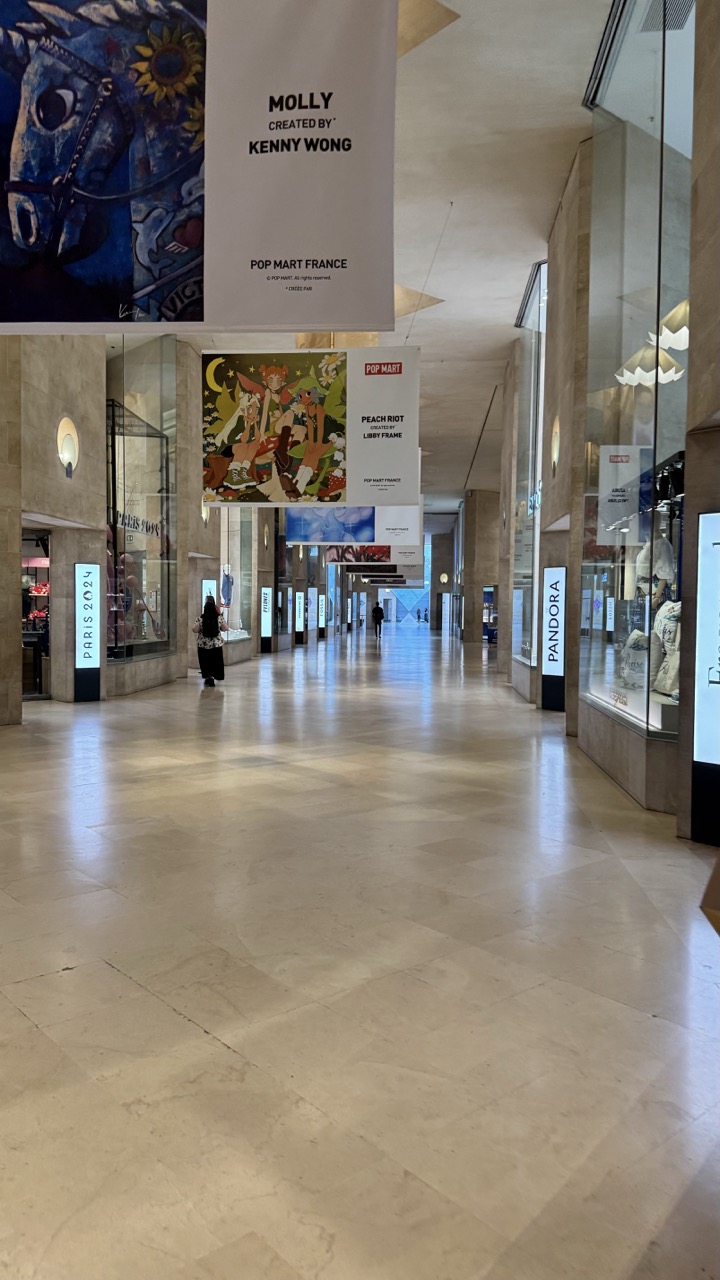

Pop Art in the Palace
Rating: 7/10 (for the quirky subject matter juxtaposition)
Step right up to the grand corridor where high art architecture meets... well, Pop Mart collectibles! This image captures a vast, polished marble hallway that feels like it belongs in a palace or a major museum complex, but is instead adorned with banners promoting cute, slightly quirky pop art characters like Molly and Peach Riot. A few lone figures wander down the expansive passage, dwarfed by the scale of the space and the towering pillars lining the route. The overall mood is one of spacious, slightly sterile calm, perhaps a quiet moment before the crowds descend, or maybe just the typical Tuesday afternoon vibe in a place this large. Signs for "PARIS 2024" and "PANDORA" add a touch of modern retail reality to the scene, hinting at the location's multi-purpose nature.
From a photographic perspective, the composition leans heavily on the strong leading lines of the floor tiles and architectural elements, drawing the eye deep into the frame and emphasizing the immense depth of the hallway. The low camera angle further accentuates this sense of scale and gives prominence to the beautifully detailed, reflective marble floor – perhaps the true star of the show, making you question if you should be shooting architecture or abstract floor patterns. Lighting is even and ambient, preventing harsh shadows but also lacking significant drama; it effectively illuminates the scene but doesn't add much character. The color palette is dominated by the neutral tones of the stone, punctuated by the vibrant, albeit slightly distant, colors of the pop art banners. It's a documentary style shot capturing a specific time and place, showcasing an interesting, slightly humorous contrast between the opulent setting and the very contemporary commercial art being advertised overhead.
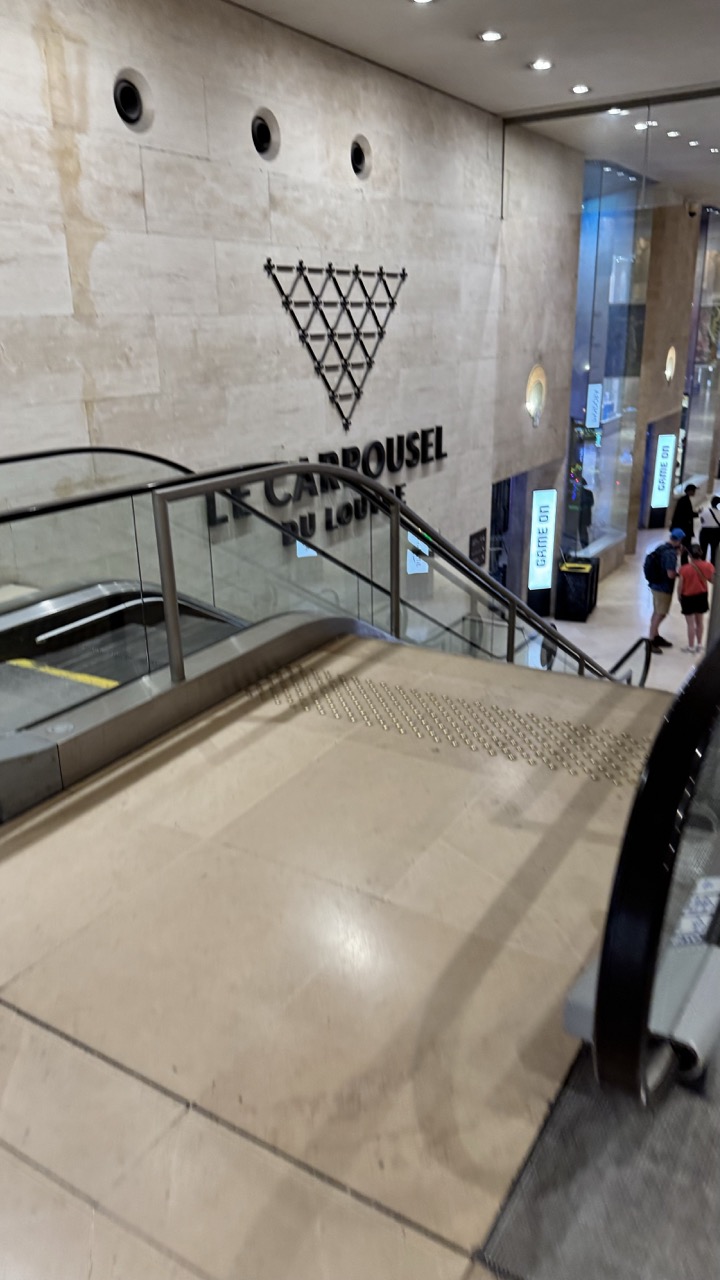

Escalating Towards Culture (or Just Games?)
Rating: 6/10
Here we find ourselves at what is apparently the entrance to Le Carrousel du Louvre, which sounds fancy, but mostly looks like the escalators to a slightly upscale, slightly generic mall. The main subject is the large beige marble wall featuring a geometric black triangle logo and the words "LE CARROUSEL DU LOUVRE" in dark lettering. A set of modern escalators dominates the foreground and mid-ground, leading the eye both up and down. In the background, beyond the wall and through some glass, a brighter, modern shopping area with "GAME ON" signage is visible, populated by a few figures, including a couple looking at a phone – perhaps checking if there's an actual game available besides navigating the labyrinthine corridors. The mood is functional and a bit sterile, typical of a modern public space, though the name adds a touch of potential intrigue.
From a photography perspective, the composition leans heavily on the diagonal lines of the escalators, which are generally dynamic but here feel a little lost against the large, static wall. The lighting is standard interior fare – even, flat, and not particularly dramatic, highlighting the texture of the marble but doing little else exciting. The color palette is muted and neutral, dominated by beige, gray, and black, with only the blue light from the "GAME ON" signs providing any significant contrast – a visual metaphor, perhaps, for the clash between high culture and modern retail. The style is candid and functional, like a quick snap taken while passing through. While it successfully documents the location, it lacks a strong focal point or artistic intent beyond capturing the scene. The foreground tactical paving dots add an unexpected textural element, presumably guiding the visually impaired, but also adding to the slightly clinical feel of the space. Overall, it's a competent but uninspired shot of a place that is perhaps more interesting for its name than its immediate visual appeal.
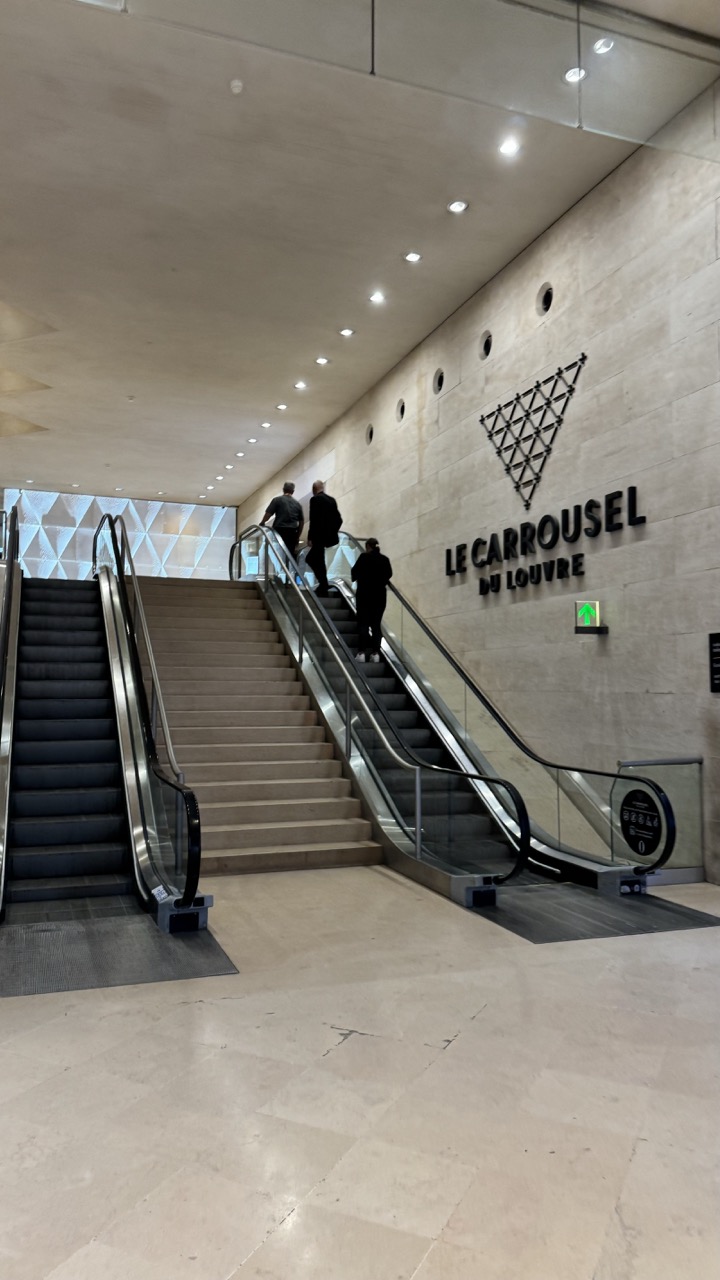

Upward Mobility at the Louvre?
Rating: 5/10 (Subject: People on escalators/stairs - riveting!)
Here we find ourselves in the bustling (or perhaps gently flowing) currents of architectural transit, specifically at what appears to be the Le Carrousel du Louvre. The scene captures a timeless human activity: going up. Three brave souls are depicted in their vertical journey, two opting for the classic stair-climbing challenge while one enjoys the effortless glide of the escalator. The mood is one of quiet efficiency, a functional passage between levels, devoid of high drama but essential for getting from point A to point B within this vast cultural labyrinth. It's a study in contrasting modes of ascent – the mechanical marvel versus the ancient step.
From a photographer's perspective, the image uses the strong diagonal lines of the escalators and stairs effectively to create a sense of depth and direct the viewer's eye upwards. The lighting, while functional for seeing where you're going, is fairly flat and uniform overhead, casting a general brightness without much character. The color palette is decidedly neutral, dominated by beige stone walls, grey metal, and the cool, sterile light, with the small green exit sign providing the only splash of color. While not a visually dynamic masterpiece, it serves as a documentary snapshot of an everyday moment in a significant location, capturing the interplay of human movement and modern architecture in a space built for facilitating flow.
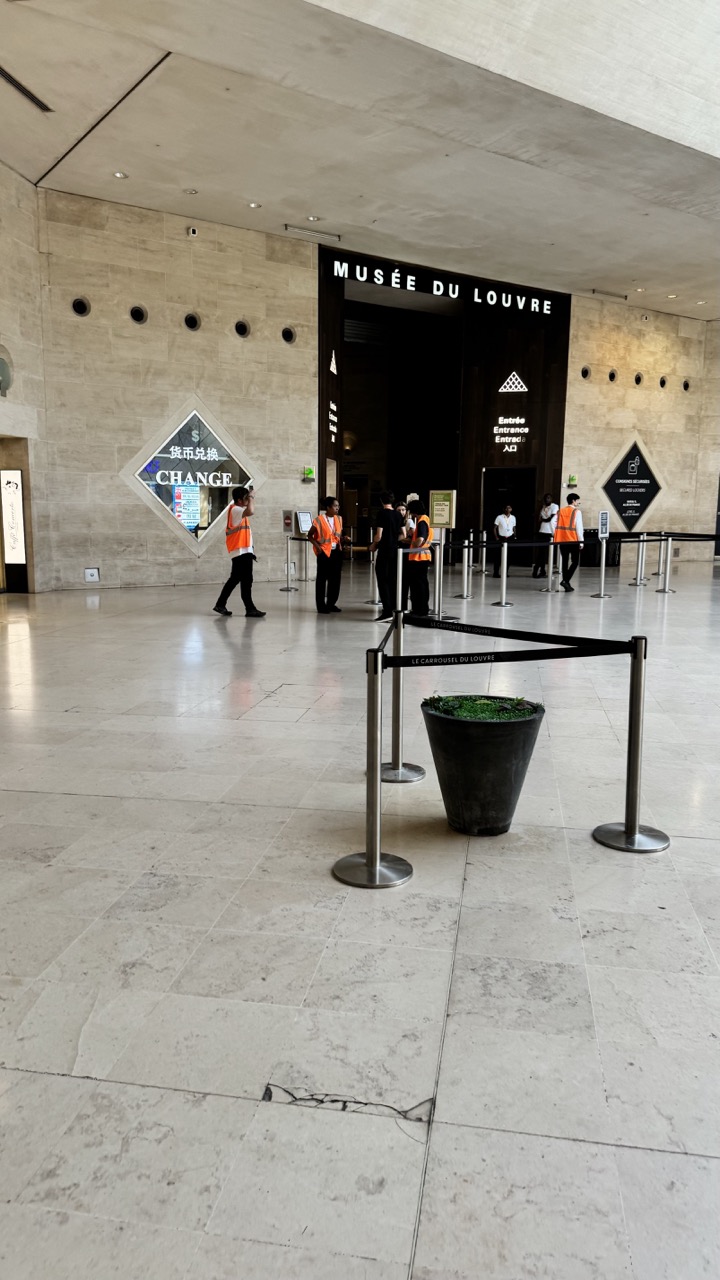

Louvre Logistics
Rating: 6/10
The scene captures the functional reality of entering the iconic Musée du Louvre, far from the hushed reverence one might expect inside. Rating: 6/10 – it's the Louvre, but viewed through the lens of queue management and necessary services rather than artistic inspiration. What's happening is the waiting game; several individuals in bright orange safety vests, looking less like art enthusiasts and more like traffic cones, are scattered around the entrance area alongside queue barriers and signage. One person near a large "CHANGE" display seems engrossed in their phone, perfectly encapsulating the modern visitor's multitasking. The mood is surprisingly mundane and practical, highlighting the operational side of running a massive museum.
From a photographic standpoint, the composition uses the foreground elements – the barrier and a rather stoic potted plant – to lead the eye towards the entrance, although they feel a bit like awkward gatekeepers. The lighting is typical of a well-lit public space, evenly illuminating everything but adding no particular drama or mood, much like museum security lighting. The color story is dominated by the neutral tones of the architecture, punctuated dramatically by the safety vests, which scream "pay attention to me!" louder than any priceless artwork. The style leans towards a candid, slightly off-kilter snapshot, capturing the reality of the scene, including the gloriously cracked floor tile in the foreground – a testament to the millions of feet that have traversed this very spot, or perhaps just a Tuesday.


Airport Security: A Study in Beige and Boredom
Rating: 3/10
This image captures the thrilling spectacle of airport security – specifically, the moment *before* you become a statistical blip on a scanner. We see the utilitarian landscape of a security checkpoint, dominated by a metal detector archway, an X-ray machine lurking ominously to the right, and the ever-present crowd control stanchions that dictate your shuffling path. A lone, partially-cropped individual is frozen in time on the left, perhaps contemplating the divestment of their outerwear or simply staring into the middle distance, lost in the profound existential dread that only a security line can induce. The scene is functional, mundane, and exudes the kind of beige-on-beige palette that suggests a life lived entirely under fluorescent lights.
Photographically, this is less a masterpiece and more a hastily grabbed snapshot, likely taken while trying not to hold up the line or attract suspicious glares. The composition is a glorious jumble, featuring a decapitated human, an off-center metal detector, and a floor pattern that seems determined to lead the eye nowhere in particular. The lighting is the typical flat, uninspired overhead glow of public spaces, doing no favors for the already dull subject matter. The colors are, generously, 'variations on grey and beige', punctuated only by the optimistic green lights on the metal detector, perhaps signaling that, against all odds, someone is cleared to pass into the next layer of airport purgatory. It perfectly encapsulates the visual excitement (or lack thereof) of travel facilitation.
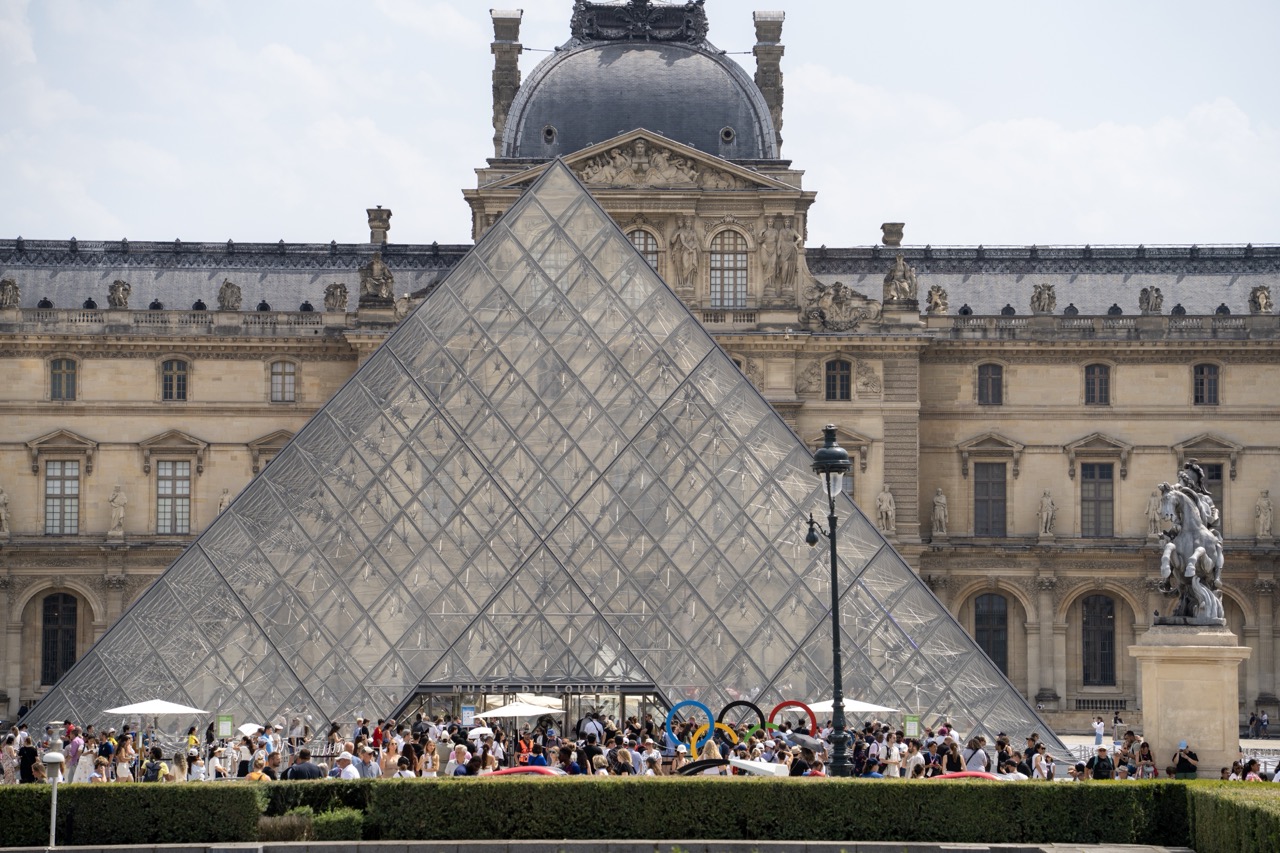

Where History Meets the Hurdles
Rating: 8/10
Behold, the classic Parisian tourist trap – the Louvre Pyramid! It's a magnificent structure, though one can't help but feel sorry for the ancient palace behind it, constantly upstaged by this giant glass Toblerone. Today, things are even more chaotic than usual, thanks to a throng of people and the sudden appearance of the Olympic rings, strategically placed like oversized, brightly colored donuts guarding the entrance. It seems even world-famous museums aren't immune to the pre-Olympic hype, turning this historical plaza into a surprisingly festive, if slightly overwhelming, scene of architectural grandeur and athletic symbolism.
From a photographic perspective, this shot captures the scene effectively, even if the lighting is a bit flat – typical of a midday Paris sky that decided to play coy with the sun. The composition leans heavily on the pyramid's strong lines, which is visually striking, but the sheer volume of humanity and the slightly distracting lamppost on the right make it feel a little crowded at the base. The vibrant Olympic rings provide a much-needed splash of color against the predominantly stone and glass palette, pulling the eye from the architectural backdrop to the foreground action. It's a great documentary shot of a specific moment, showcasing the blend of art, history, and impending sporting madness, even if trying to find a clear view of the Louvre itself feels like an Olympic sport in itself.
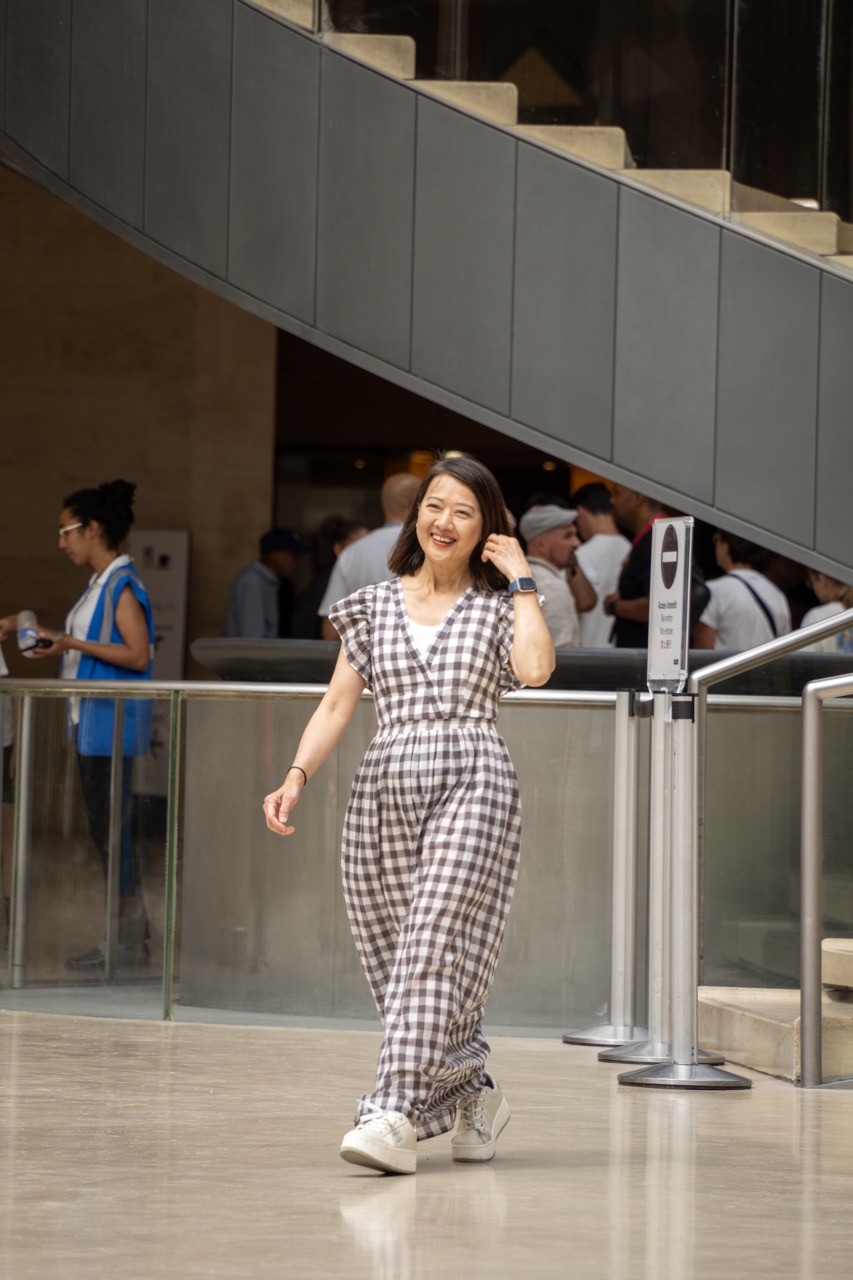

Gingham Gallop
9/10
Captured in a moment of pure, unadulterated joy, our subject radiates happiness as she strolls through what appears to be a grand public building – perhaps escaping a queue for an exhibition about the history of large staircases or simply enjoying a moment of freedom. Her striking monochrome gingham jumpsuit makes her pop against the muted architectural backdrop, while her infectious smile and playful hand-in-hair gesture tell a story of carefree movement. The mood is decidedly upbeat, a refreshing slice of candid life amidst the likely hustle and bustle around her, grounding the shot in a relatable human experience amplified by the glimpse of queue stanchions and other patrons in the background.
From a photography perspective, the composition uses the railings and background elements like the impressive brutalist staircase to frame her movement effectively, though the busy background does slightly compete for attention – maybe a wider aperture was needed unless the staircase was the *real* subject all along? The low angle adds a touch of dynamism, making her feel larger than life as she walks towards the viewer, while the natural light beautifully highlights her features without harsh shadows. The overall style is candid street portraiture, successfully freezing a fleeting moment of genuine emotion. Bravo on capturing the sparkle in her eye and the confident stride in her white sneakers, watch glinting on her wrist, even if we're left wondering where that impressive staircase actually leads!
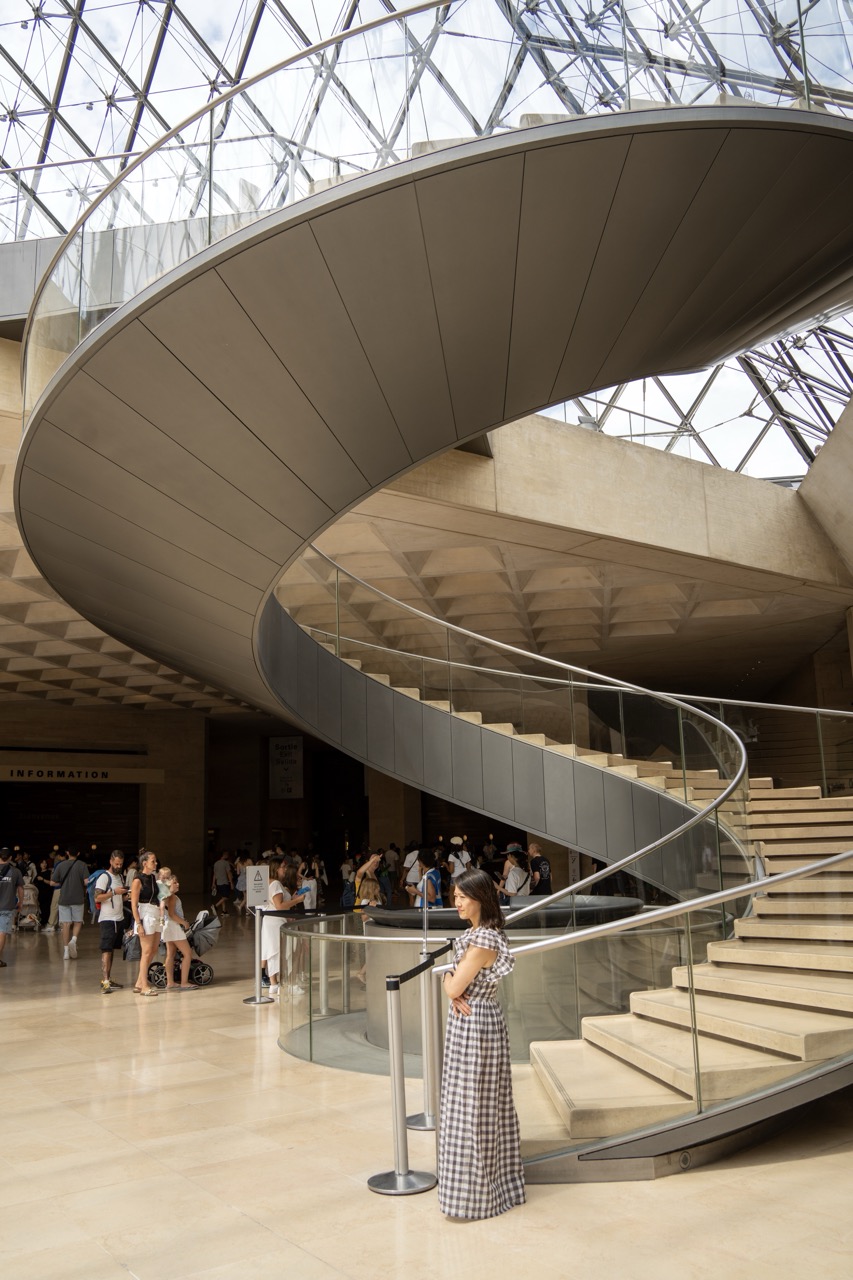

Louvre Elegance
Rating: 8/10
Here we find a moment captured within a truly grand space, likely the bustling interior of the Louvre Pyramid, judging by the iconic geodesic roof structure peeking through. Our central subject, rated an 8 for her composed presence and stylish checkered dress, stands patiently in the foreground, arms crossed, looking off to the side. She provides a focal point amidst the constant flow of humanity swirling around the base of an impressive, sweeping spiral staircase. The mood is one of quiet waiting or observation within a vast, active environment. Below the architectural drama, a typical scene unfolds: a crowd of tourists and visitors mill about, some possibly queuing or seeking information near the clearly marked 'INFORMATION' sign. The glossy marble floor reflects the light, adding to the sense of scale and polished modernity.
From a photographic perspective, the composition masterfully balances the human element with the imposing architecture. The magnificent spiral staircase acts as a powerful leading line, drawing the eye upwards and around, while the woman's placement off-center anchors the foreground. It's a classic struggle in travel photography: how to capture the grandeur of a location while still including a compelling human subject without having them swallowed by the scale or obscured by crowds. Here, the photographer succeeds reasonably well, although the woman is quite close to the frame's edge. The lighting, provided by the massive glass roof above, is beautifully soft and diffused, illuminating the concrete textures and the clean lines of the staircase without creating harsh shadows. The color palette is predominantly neutral, letting the architecture and the woman's patterned dress stand out. Despite the inherent challenge of shooting in a busy tourist hotspot, the image manages to feel both grand and personal, perhaps capturing the universal experience of waiting amidst the awe-inspiring. And let's be honest, finding a spot for a clear shot without someone photobombing is a victory in itself!
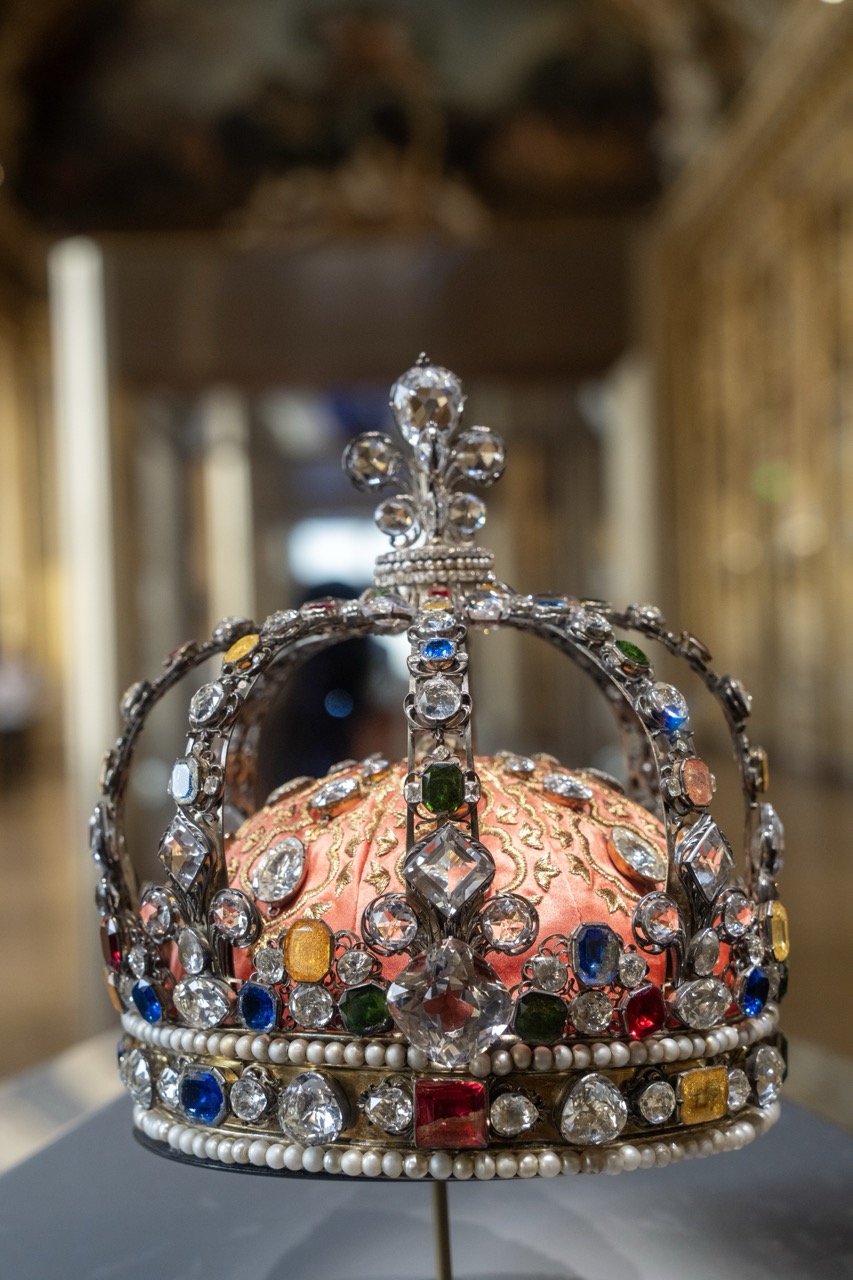

Royal Bling Extravaganza
Rating: 10/10 (Seriously, look at it. It's a crown!)
Alright, feast your eyes on this magnificent display of regal excess. What we have here is a crown, and not just any crown – it's dripping with jewels, pearls, and enough sparkle to make a disco ball jealous. It's sitting proudly on a rather lovely, slightly-too-puffy pink cushion embroidered with gold thread, because apparently, even crowns need a comfy seat. The mood is undeniably opulent and historical, perhaps even a tad ostentatious, screaming "I have more wealth than you can possibly imagine!" The composition is a classic, tight shot, placing the crown front and center, commanding attention. The lighting is doing its job, catching the facets of every diamond and gem, creating those essential highlights and sparkles that make jewelry photography *sing*. The colors are rich and varied – the deep blues, vibrant greens, fiery reds, sunny yellows, and countless clear stones all pop against the soft pink and the subtle, earthy tones of the metalwork. Style-wise, it's straightforward object photography, focusing on showcasing the intricate detail and sheer beauty of the subject.
From a photographer's perspective, this shot nails the focus on the main star. The depth of field is shallow enough to beautifully blur the background, eliminating distractions and making the crown leap off the screen, while still hinting at its environment – a grand, slightly out-of-focus hallway with architectural details and a blurry ceiling painting suggesting it's likely on display in a museum or historical building. The reflection in some of the larger stones adds a nice touch, even if it just reflects the blurred surroundings. While the lighting is great for sparkle, managing reflections on so many polished surfaces without getting weird hot spots or seeing your own reflection is a constant battle – whoever shot this did a pretty good job avoiding major catastrophes. The slight tilt adds a touch of dynamism, keeping it from being just a static, straight-on shot. Overall, a solid capture of a truly stunning, over-the-top piece of history that probably weighed a ton and caused a few neck aches back in the day.
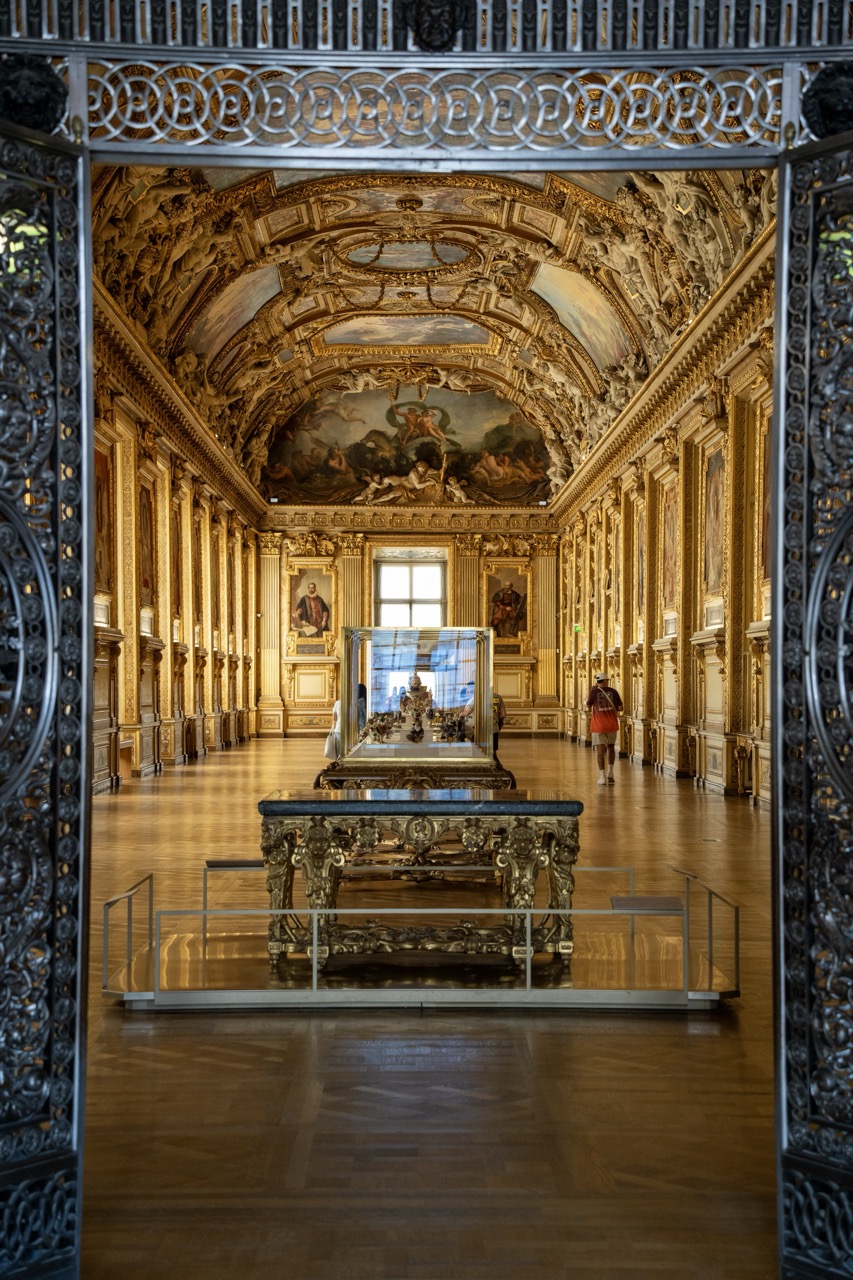

Gilded Grandeur Through the Looking Gate
Rating: 9/10
Step right up, folks, but don't touch anything! This image transports us through an incredibly ornate doorway into a hall so gilded, Midas himself would blush. The subject is this mind-bogglingly opulent gallery – a solid 9/10 for sheer "wow" factor. What's happening is less of a bustling scene and more of a quiet reverence; a lone figure in bright red and white saunters down the endless golden corridor, perhaps contemplating which era had the most extravagant interior designers, while a couple of others hover near a glass display case. The mood is one of quiet grandeur, bordering on overwhelming luxury, like walking into a billionaire's attic – if that billionaire was also a god of wealth.
From a photography perspective, the composition is genius, using the dark, elaborate metalwork of the gate as a perfect frame, pulling your eye straight into the vanishing point down the hall. It's a classic "frame within a frame" shot that adds incredible depth. The lighting is a delightful mix of soft natural light from the distant window and focused spotlights, creating a warm glow that highlights every single piece of gold leaf (and there's a lot). The color palette is dominated by warm golds and browns, punctuated by the rich hues of the ceiling fresco and paintings – it's almost a visual overload of richness. The details are insane – from the intricate carvings on the columns to the patterns on the floor. The walking person isn't just a visitor; they provide scale, reminding you just how immense and grand this space is. It makes you wonder if they got lost trying to find the exit or just decided this was the best place to take a leisurely stroll among centuries of shiny things.
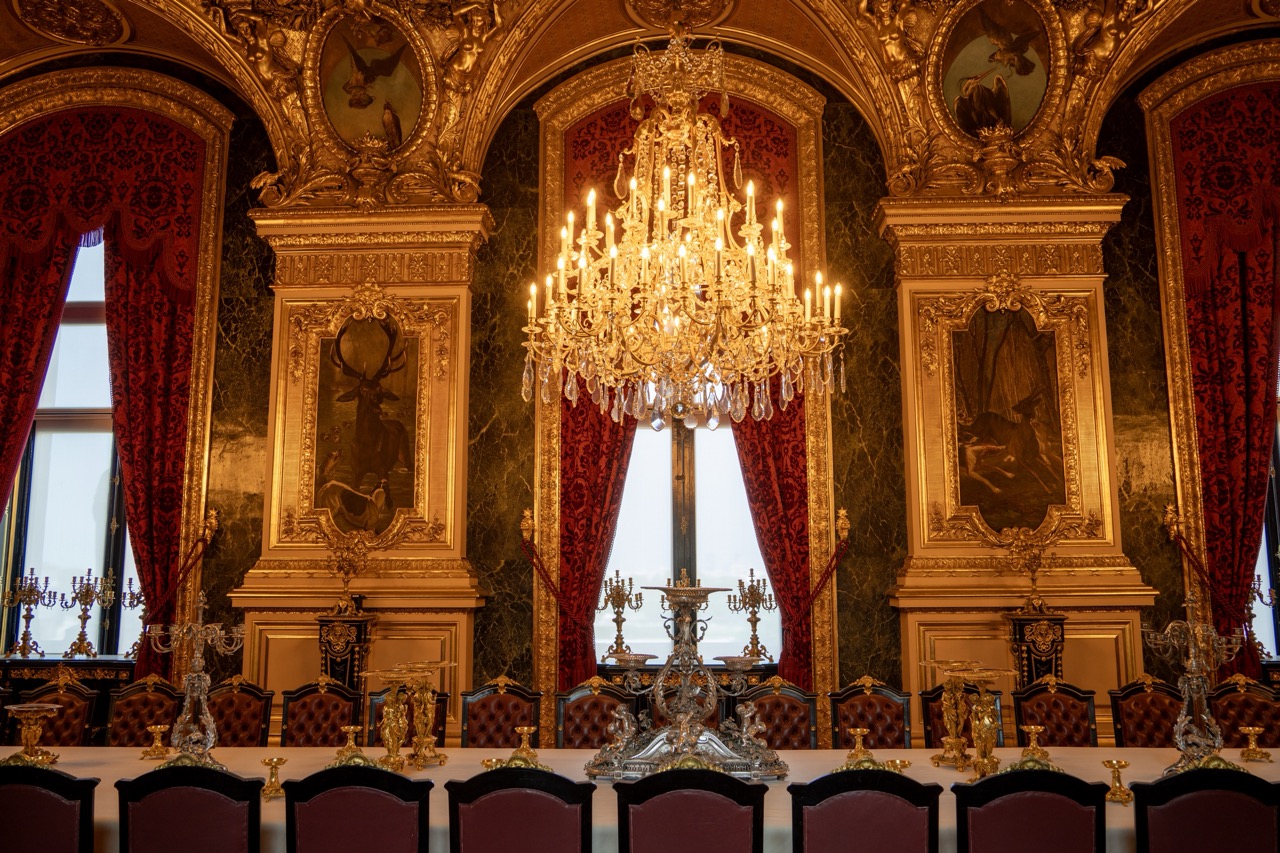

The Gilded Cage Feast Hall
Rating: 9/10
Welcome to a dining room that screams "more is more," where every surface seems to be competing for the title of "most unnecessarily opulent." This photograph captures a lavish, formal dining hall, seemingly paused just before a gathering of folks important enough to own this much gold. A long, dark wood table stretches into the distance, flanked by numerous high-backed chairs upholstered in a rich, deep red. Above, a truly magnificent crystal chandelier hangs like a dazzling, overenthusiastic disco ball from a bygone era, casting a warm, glittering light across the scene. Heavy, patterned red curtains frame tall windows, adding to the dramatic, almost theatrical, atmosphere. It’s the kind of place where dropping a fork would likely echo for an awkward eternity.
From a photographic standpoint, the composition leans heavily on symmetry, centering the eye perfectly on the grandiose chandelier and the light-filled window behind it, reinforcing the room's formal rigidity. The lighting is primarily warm and incandescent from the chandelier, which does a fantastic job of highlighting the ridiculous amount of gold leaf and sparkling crystal. However, some natural light leaks in from the window, providing a softer counterpoint and showcasing the lush texture of the curtains. The color palette is unapologetically rich – deep reds, burnished golds, and dark, almost black-green walls creating a sense of intense luxury, though perhaps a little claustrophobic. The walls feature large, ornate golden frames housing paintings of what appear to be hunt scenes – a slightly intense choice for a dining backdrop, unless you plan on chasing your dessert. Overall, it's a technically competent shot that perfectly captures the overwhelming grandeur and slightly ostentatious style of the space, making you wonder if they polish the chandelier daily.
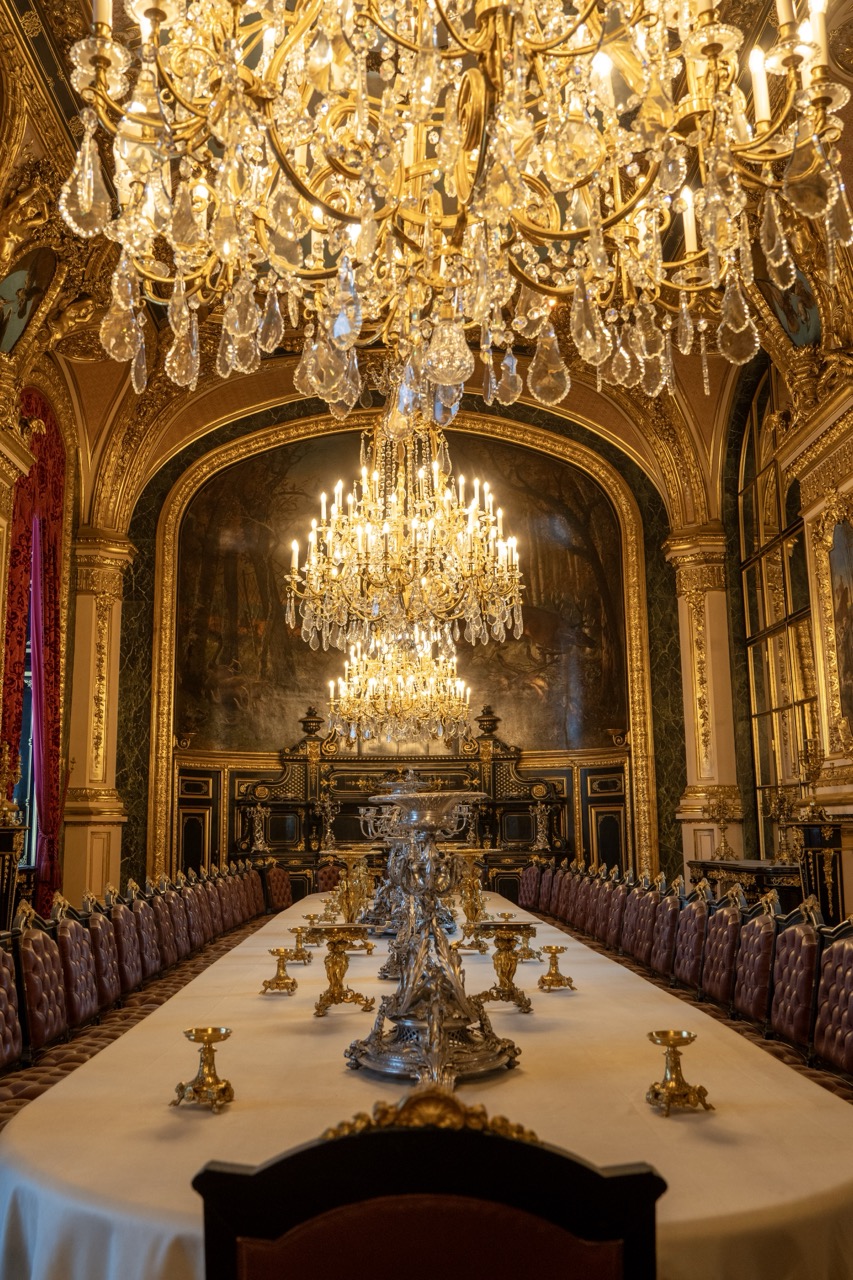

The Blinding Brilliance of Dinner
Rating: 9/10
Subject: An incredibly opulent dining room, a visual symphony of gold, crystal, and fine upholstery. This scene scores a dazzling 9/10 for its sheer, unapologetic display of wealth and historical grandeur, leaving the viewer somewhere between awestruck and wondering just how many people it takes to polish those chandeliers. What's happening is essentially a static portrait of potential; the table is set, the room is lit, but the feast has yet to begin, leaving a palpable sense of anticipation for a gathering that would surely involve more courses than anyone could reasonably consume. The mood is one of immense formality and historical weight, radiating an atmosphere that demands you sit up straight and maybe brush up on your obscure historical etiquette before taking a seat. Pertinent objects include an excessive number of sparkling crystal chandeliers raining light down, a seemingly endless dining table laden with ornate silver and gold centerpieces, and rows of plush, tufted dining chairs waiting patiently for their occupants.
The background scene is a masterclass in maximalism, featuring deep red drapes, gilded wall panels, and a large, moody painting depicting a forest scene behind an elaborate sideboard. From a photography perspective, the composition is elegantly symmetrical, drawing the eye down the long table towards the central background elements, effectively conveying the scale and depth of the room. The lighting, primarily from the numerous chandeliers, is the star here; it creates brilliant highlights on the crystal and gold, giving the image its radiant quality, although one might critique that it leaves some of the corners in relative shadow, adding drama but perhaps obscuring some details. The color palette is dominated by rich, warm golds and reds against darker greens and blacks, perfectly capturing the luxurious, historical style. It's a photographic approach that embraces the room's theatricality, using light to emphasize texture and sparkle, making the image feel less like a room and more like a treasure chest burst open, requiring the photographer to manage overwhelming brightness while still capturing the intricate details. It’s clearly a style that believes if a little sparkle is good, a lot is probably better, and the photo embraces that philosophy wholeheartedly.
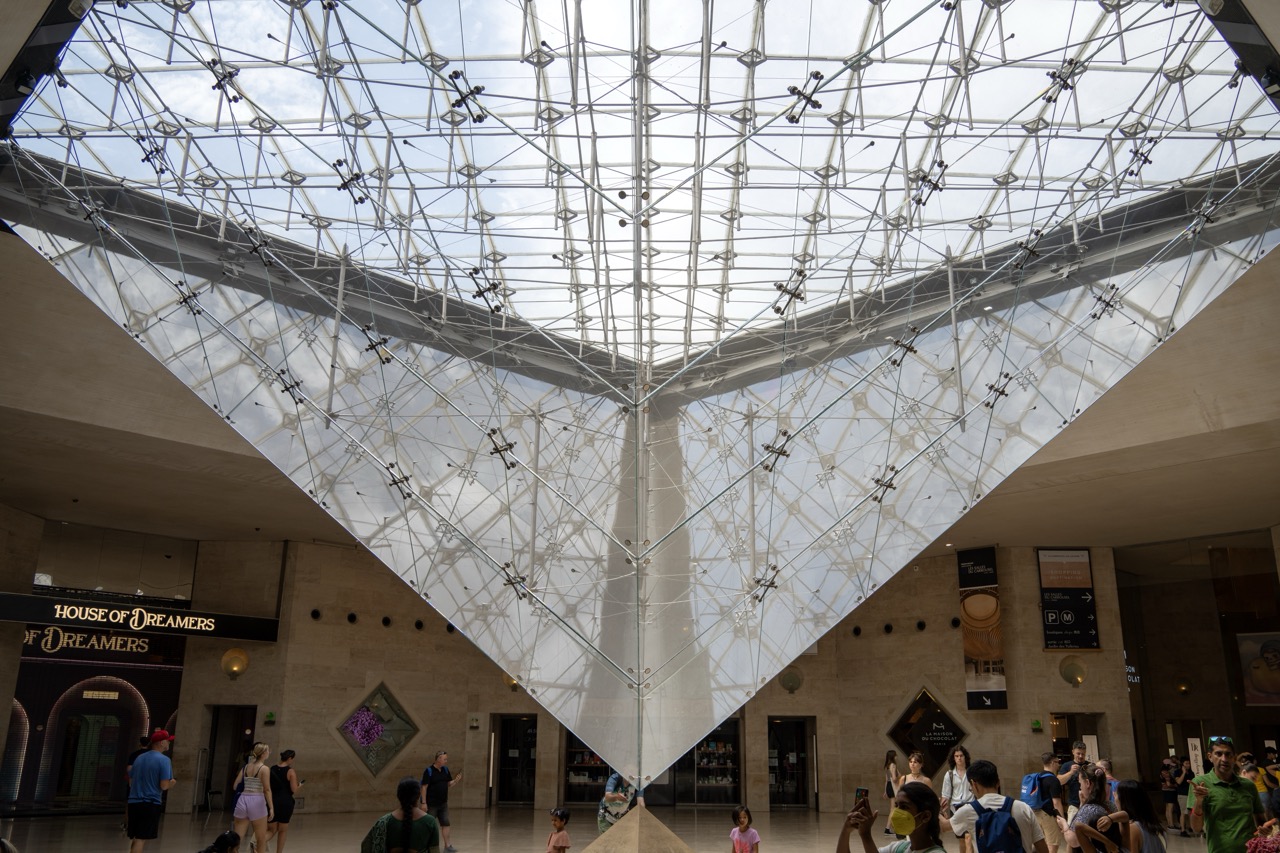

Louvre's Heart of Glass
Rating: 7/10
Beneath the grand glass ceiling of the Louvre, the inverted pyramid structure dominates the frame, a marvel of modern architecture bringing the sky indoors. The scene below is bustling with visitors meandering through the cavernous space, some pausing to look at signs directing them to various points of interest, while others simply take in the scale of their surroundings. The mood is one of contained energy, a paradox of hushed museum tones mixed with the low hum of crowds, all under the watchful, geometric eye of I.M. Pei's controversial yet iconic addition. It’s the classic tourist experience writ large, framed by structural elegance.
From a photographic perspective, this shot tackles the classic challenge of high dynamic range, with the bright sky visible through the glass contrasted against the relatively dimmer interior space. The composition effectively uses a low angle to emphasize the soaring nature of the structure, drawing the eye up into the intricate web of metal supports and glass panels, a fascinating pattern in itself. While the inclusion of people provides scale and context, adding a touch of street photography to the architectural focus, they also create visual clutter – a common nemesis when trying to capture clean lines in famous landmarks. The lighting, while challenging, creates dramatic reflections and highlights on the glass, showcasing the interplay between light and material, even if it pushes the camera sensor to its limits trying to balance the bright upper section with the darker base. Capturing such a busy, immense location is always a juggling act between documenting the place and finding a unique perspective, and this shot offers a solid, if familiar, view of the Louvre's modern heart.
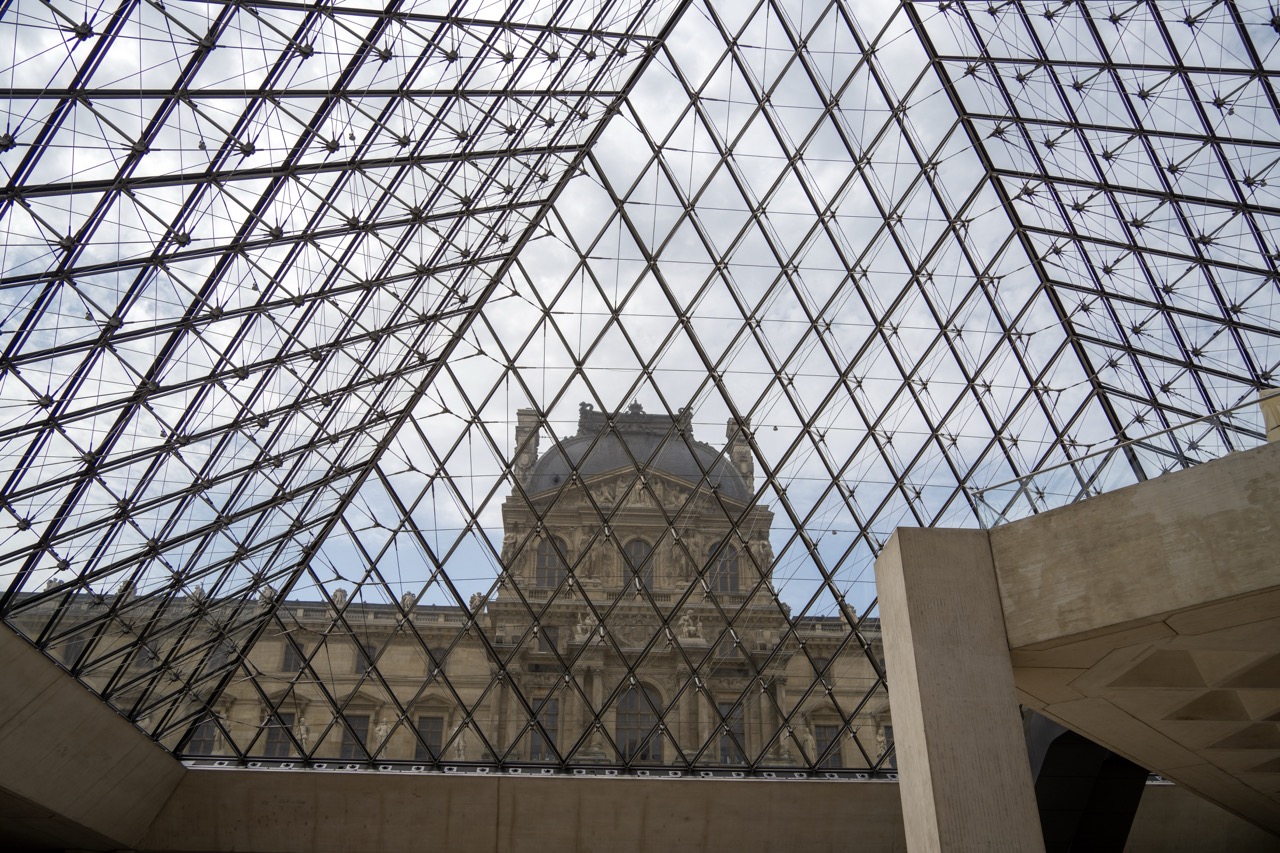

Geometric Gazing: Inside the Louvre Pyramid
Rating: 8/10
Peering out from within the iconic glass shell of the Louvre Pyramid, we are treated to a geometrically framed view of the classic museum building itself. The intricate lattice of steel and glass creates a mesmerising diamond pattern that dominates the foreground, acting as a high-tech filter over the historic stone facade beyond. It’s a fascinating juxtaposition – the stark, modern minimalism of I.M. Pei's pyramid clashing wonderfully with the ornate, centuries-old architecture of the palace. The mood is one of structural wonder and historical perspective, as the eye navigates the clean lines of the present to reach the detailed curves of the past, all under a soft, diffused sky.
From a photographer's perspective, the composition is the clear star here, expertly using the pyramid's structure to create a powerful frame-within-a-frame effect. The lines draw your gaze directly to the central dome and facade of the Louvre building. The lighting, courtesy of an overcast sky, is even and gentle, which is great for revealing the texture and detail on the building's exterior without harsh shadows, though it does make the sky look a little... well, grey. The color palette is muted, relying on the neutral tones of concrete, glass, metal, and stone, which reinforces the focus on form and structure. It's a classic architectural shot that highlights the conversation between two very different eras of design, proving that sometimes, the best view is had by looking through something rather than just at it.
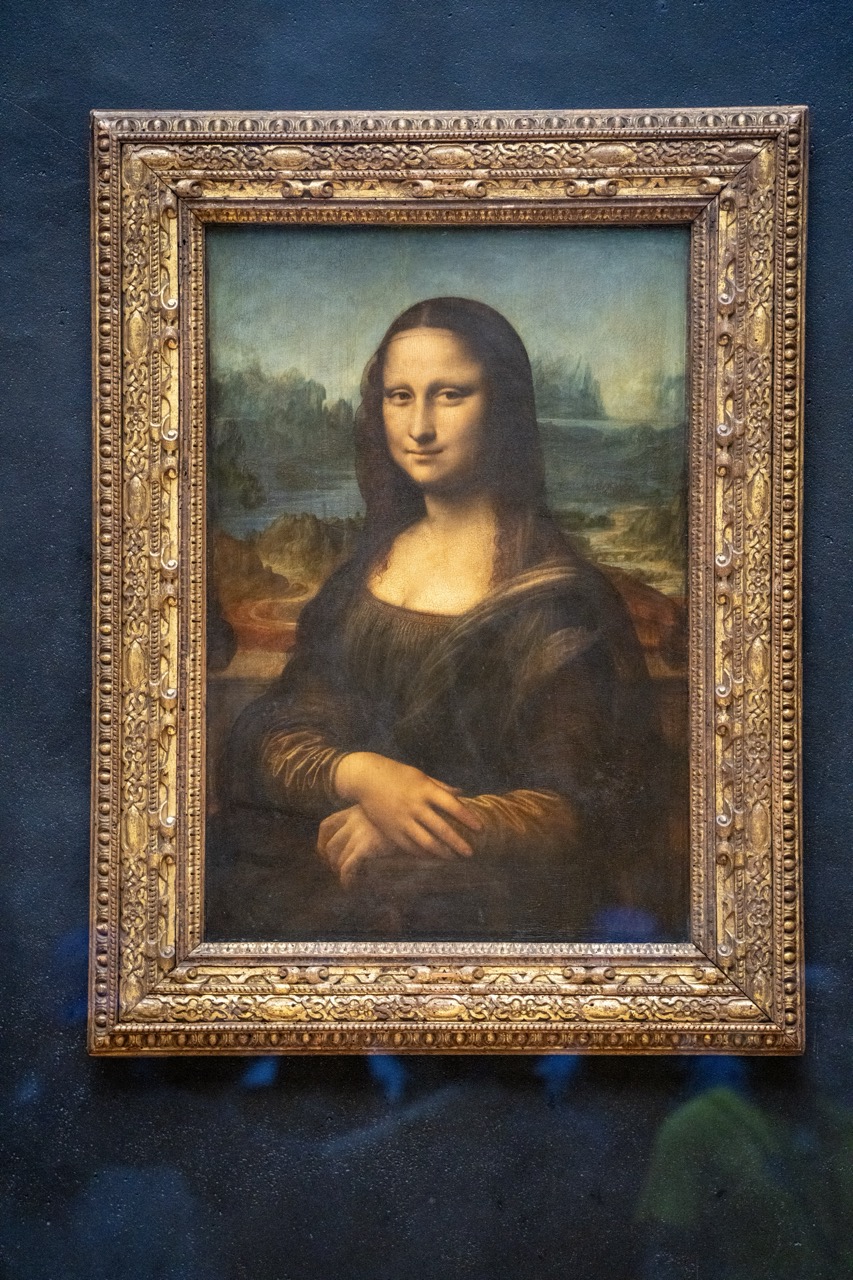

The Unavoidable Icon
Rating: 9/10
Alright, let's talk about the big one. This is *the* Mona Lisa, rated a generous 9/10 for sheer, unavoidable fame, though perhaps only a 7/10 for photogenic accessibility behind that barrier and glass. What's happening here is the photographic equivalent of trying to capture Bigfoot – a fleeting, often obstructed view of something everyone wants to see. The scene is simple: the legendary portrait centered within its elaborate, gilded frame, presented against a dark, nondescript wall. Compositionally, it's a classic formal presentation, letting the artwork dominate the frame, but the context of the wall and subtle reflections hints at the real-world museum environment. The mood is one of hushed awe mixed with the palpable energy of the crowds perpetually gathered around it, a buzz that this photo only hints at through the unfortunate but expected reflections.
From a photography perspective, this is a masterclass in battling environmental obstacles. The lighting, likely a mix of ambient and targeted museum lights, creates challenging reflections on the protective glass, adding ghostly shapes and glares that are the bane of every art photographer's existence in places like the Louvre. The colors are the painting's signature deep, rich sfumato tones – browns, greens, and the pale, warm skin – beautifully contrasted by the vibrant, heavily textured gold of the frame. The subject matter itself needs no introduction: the famous smile, the serene pose, the misty, dreamlike background landscape. Capturing this image requires patience and a bit of luck to minimize glare and capture the details through the barrier, highlighting the technical challenge of documenting such a popular piece where you can't control the light or distance. It's less about artistic composition of the photo itself and more about achieving a clear, well-exposed record of the iconic subject under difficult conditions.
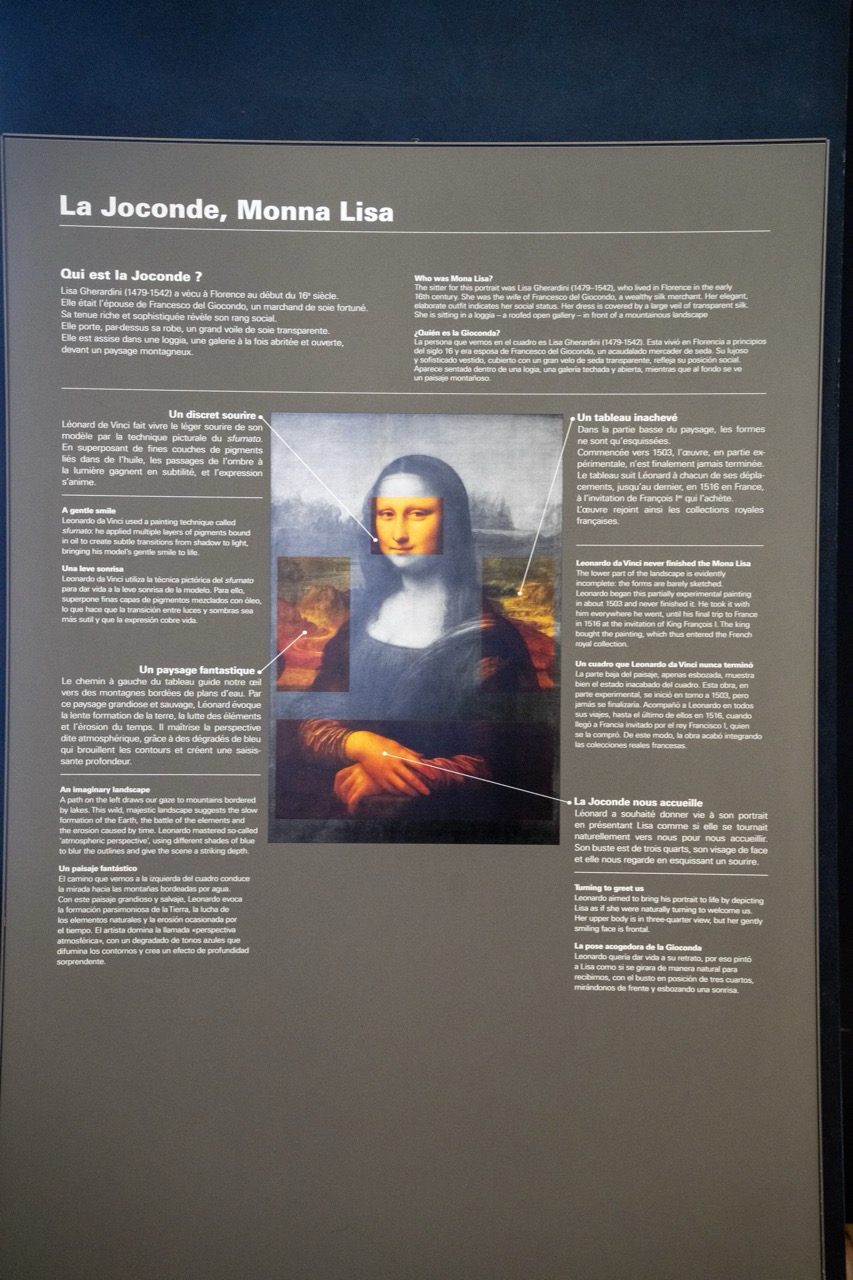

La Joconde, Monna Lisa's Museum Moment
Rating: 6/10
Capturing the world's most famous painting isn't easy, especially when it's tucked away behind glass and crowds, forcing you to photograph an informative display panel instead. This shot gives us a glimpse into the educational side of the Louvre, showcasing a panel dedicated to the Mona Lisa, or "La Joconde, Monna Lisa" as it's presented here. The composition is a standard straight-on documentary style, though the angle is slightly tilted, a common struggle when trying to avoid reflections and security guards in a museum environment. The lighting is typical museum fare – functional but uneven, highlighting certain areas of the panel while leaving others slightly dimmer, adding a touch of photographic realism (or maybe just demonstrating the challenges of low-light, no-flash situations). The subject is clear: a reproduction of the masterpiece, accompanied by dense blocks of text in multiple languages – French, English, and Spanish – dissecting the painting's mysteries.
The display itself is well-structured, using white lines to point out specific features of the Mona Lisa image, such as her "un discret sourire" (a gentle smile), her hands, the landscape, and her pose. This visual breakdown attempts to make the genius of Da Vinci more accessible, even if the photo quality here makes squinting necessary to read the finer print. It’s almost ironic that the immortal smile of the Mona Lisa is presented via a slightly blurry reproduction on a panel captured with less-than-perfect focus and framing. Despite these technical shortcomings of the photograph, it effectively conveys the experience of learning about the painting in situ – a quick snap taken amidst the museum hustle, preserving the information panel for later digestion. It's a reminder that sometimes, the photos aren't technically perfect, but they capture a moment and provide valuable context, even if that context is explaining a painting you couldn't get close enough to see properly.
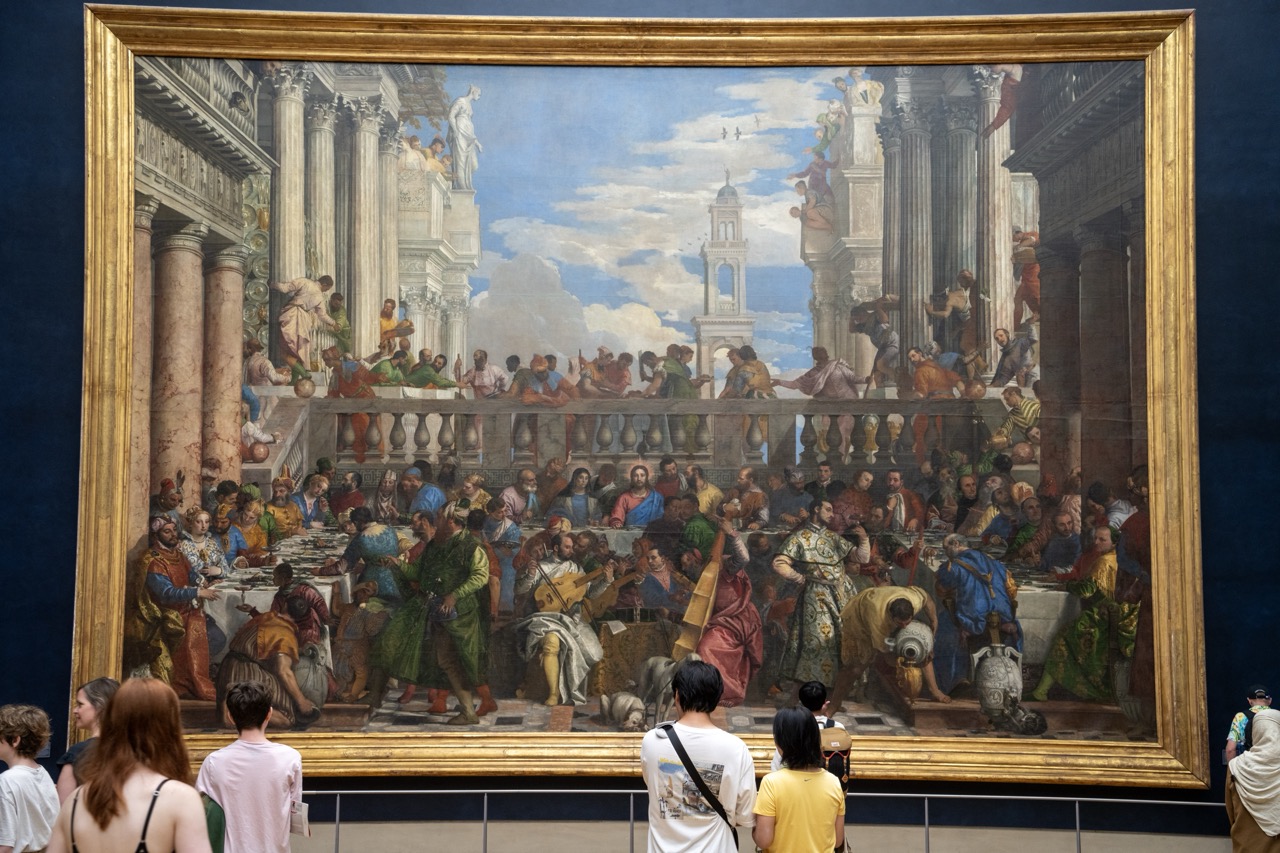

The Epic Feast in the Frame
Subject Rating: 9/10
Behold, a feast fit for kings, and painted on a canvas large enough to probably *host* one! This is a stunning capture of Paolo Veronese's colossal masterpiece, "The Wedding at Cana," where Jesus performed his first miracle, though judging by the sheer number of guests and musicians, it looks more like a Renaissance rave than a humble wedding reception. The painting itself is a vibrant explosion of color, architectural grandeur, and bustling figures, packed onto a scale that demands attention. The composition is a masterful blend of ordered classical architecture towering over the chaotic energy of the lower levels, with intricate details in every brocade robe and musical instrument. The mood is undeniably lively and celebratory, capturing a moment of worldly revelry alongside a divine event, rendered with the opulent brushwork characteristic of the Venetian school. It's a visual spectacle that makes you want to pull up a chair (if you could find one).
From a photographer's perspective, capturing this beast of a painting is a feat in itself. The composition here nicely frames the entire artwork within its ornate gold setting, emphasizing its monumental size by including the dark museum wall around it and the floor below. The inclusion of fellow museum-goers in the foreground adds crucial scale and a touch of reality to the grand illusion on the wall. Their presence, while sometimes a minor obstruction, provides a relatable human element – tiny figures standing in awe (or perhaps just tired) before this enormous work of art. The lighting appears relatively even, minimizing glare on the potentially reflective surface of the painting, which is a common pitfall in museum photography. The contrast between the bright, detailed painting and the dark, simple background helps the subject pop. It's a solid shot that documents the experience of viewing such an imposing masterpiece, capturing not just the art, but the act of appreciating it.
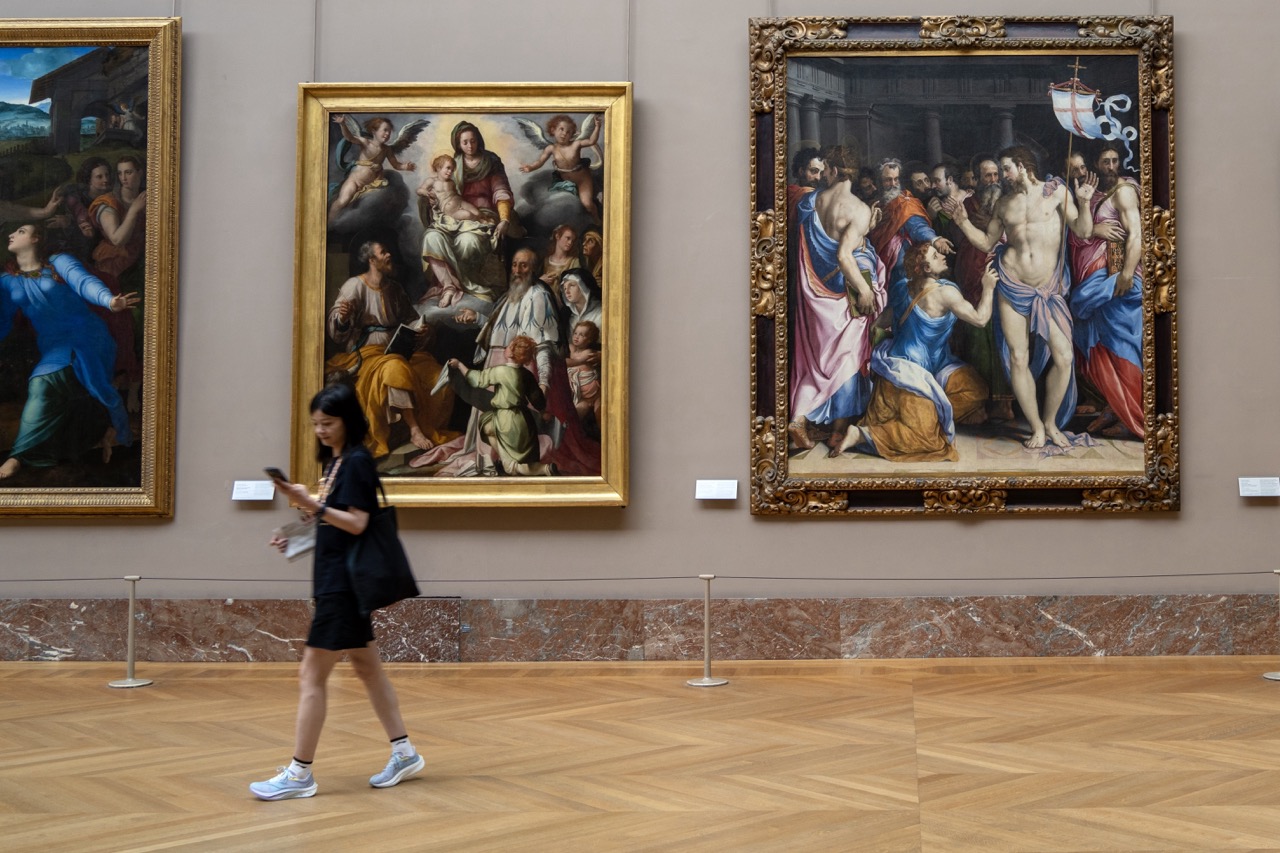

Museum Contemplation, Modern Style
Rating: 7/10
Here we have a classic museum scene, but with a delightful modern twist. Our main subject, a woman, drifts through the hallowed halls, seemingly engrossed in the masterpieces on display... or perhaps just checking her email. The action is simple: she's walking from left to right, phone in hand, a ubiquitous accessory in our digital age, even when surrounded by centuries of artistic achievement. The mood is quiet and reflective, typical of a museum, yet her focused gaze downwards introduces a subtle note of disconnect. The grand scale of the paintings dwarfs the solitary figure, creating a sense of individual experience amidst the collective history of art. Pertinent objects abound: the ornate frames, the barriers keeping patrons at a respectful distance, the polished parquet floor reflecting the muted light, and of course, the star of the show – the phone.
From a photographic perspective, the composition places the subject off-center, using the rule of thirds to guide the eye. The strong vertical lines of the paintings and the horizontal line of the marble base create a structured background against which the moving figure provides dynamic contrast. Lighting is soft and even, highlighting the rich colors of the paintings while leaving the person in a slightly dimmer, more naturalistic tone. The color palette is dominated by the warm browns and reds of the frames and floor, offset by the cooler grey walls and the vibrant, if somewhat faded, hues within the artworks themselves. It’s a candid shot, capturing a fleeting moment that perfectly encapsulates the contemporary museum experience – a blend of awe-inspiring history and undeniable present-day distraction. The photographer clearly intended to show this interaction, or perhaps lack thereof, between the visitor and the visited.
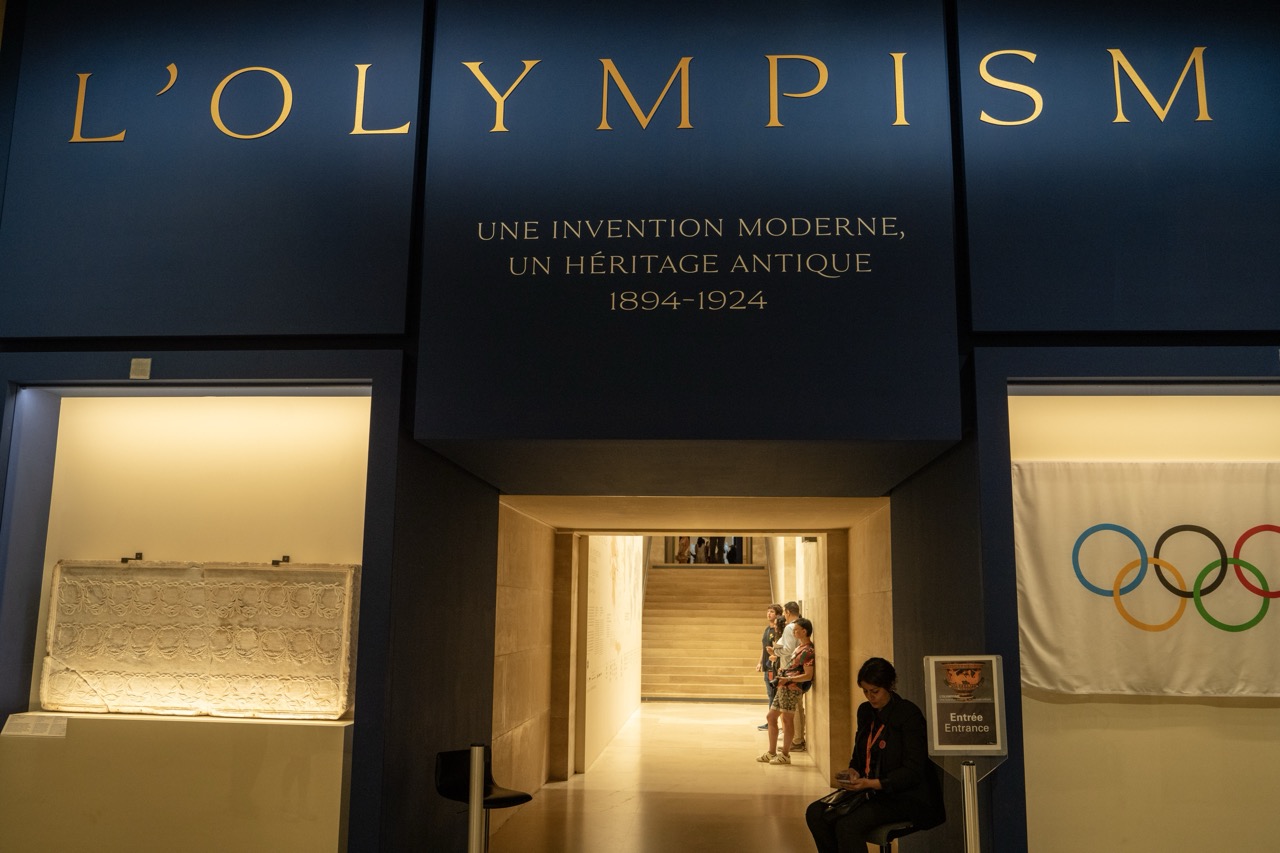

Gateway to the Games' Past
7/10
Step right up, history buffs and future athletes alike! This shot captures the grand entrance to an exhibition titled "L'OLYMPISM - UNE INVENTION MODERNE, UN HÉRITAGE ANTIQUE 1894-1924." Dominating the scene are the striking gold letters against a deep blue wall announcing the theme, while below, a warmly lit tunnel beckons visitors forward. To the left, an ancient relief rests in a display case, looking suitably old and important, perhaps contemplating the evolution of athletic fashion. To the right, the vibrant, instantly recognizable Olympic rings flag hangs proudly. A few keen individuals are already making their way into the tunnel, presumably eager to soak up some history, while a diligent museum attendant stands guard (or perhaps just checks emails) near the multilingual "Entrée Entrance" sign. Beyond the tunnel, stairs hint at further exploration within this temple of sporting history.
From a photographic perspective, the composition uses strong vertical and horizontal lines to frame the central passage, creating a sense of depth and invitation, like a historical wormhole calling your name. The lighting is strategically employed, highlighting the exhibition title and drawing the eye towards the bright tunnel entrance, cleverly contrasting with the dimmer foreground and walls – a classic museum trick to make the artifacts seem even more significant. The dark blue and gold colour palette lends an air of gravitas and importance, fitting for a historical subject, punctuated nicely by the pop of primary colors from the Olympic rings. It's a functional, informative shot typical of documenting an exhibition space – perhaps lacking a bit of dynamic action, but effective in conveying the atmosphere and key information. The composition feels balanced, though maybe a tad too symmetrical for some tastes, perfectly capturing the 'this is where the history begins' moment, even if the attendant looks ready for coffee.
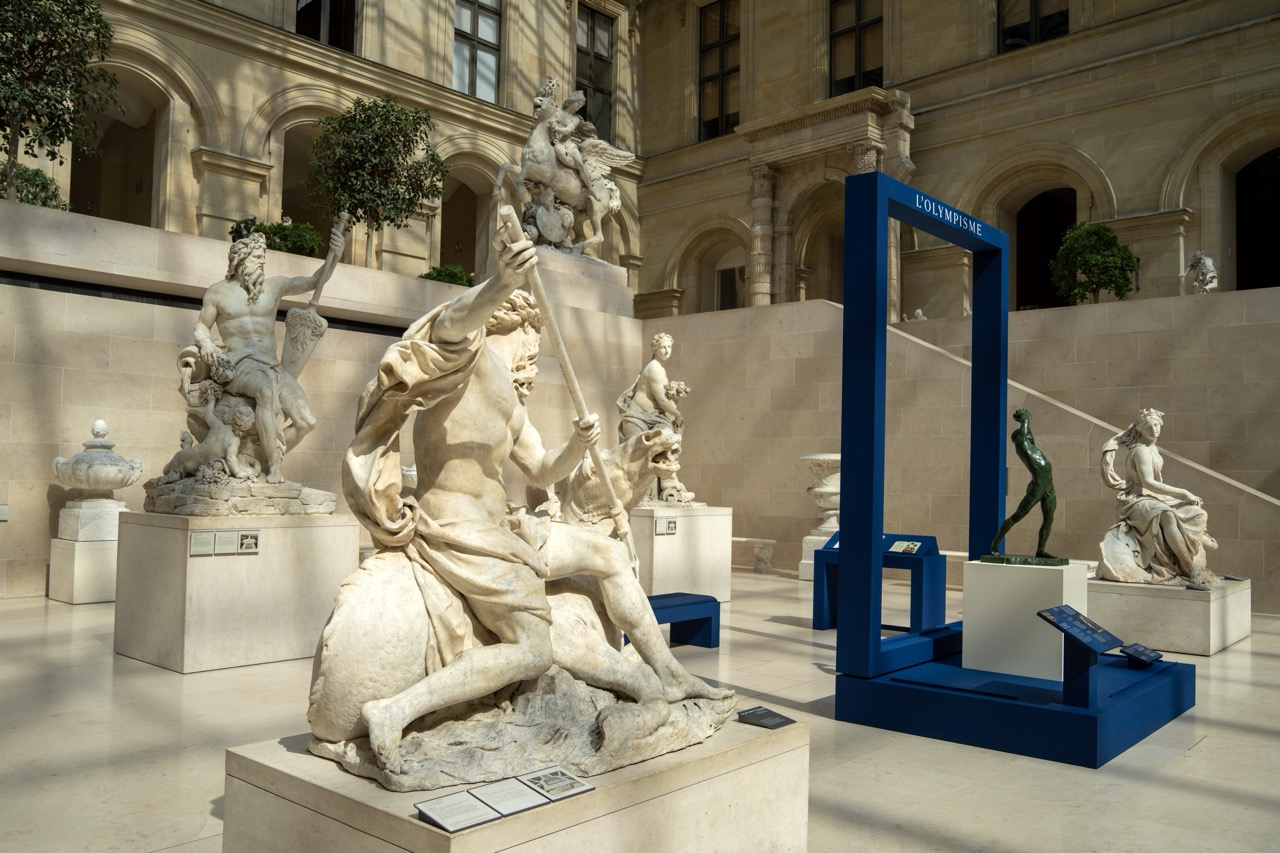

Title: Grandeur and Blue Frames: A Sculptural Gathering
Subject Rating: 8/10
Welcome to the Louvre, or perhaps a similarly magnificent hall, where ancient artistry meets modern display choices. The subject here is the impressive collection of marble sculptures, each seemingly caught mid-epic narrative or moment of serene contemplation. We have the guy with the leafy staff looking like he's guarding a very fluffy sheep, another muscular chap riding a mythical beast (Pegasus, is that you?), and a seated goddess just chilling on a rock like it's her throne. The star of the show, compositionally centered, is the dynamic figure brandishing a spear, striking a classic "Don't mess with me" pose. The overall mood is one of hushed reverence for history, juxtaposed with a touch of "What's with the big blue picture frame?" from the exhibition designers. It’s a grand, sun-drenched space perfect for pondering the timeless human form, even if some elements feel like they were airlifted from a contemporary art fair.
From a photography perspective, the composition utilizes the depth of the hall effectively, leading the eye from the foreground sculptures back to the grand architecture and the controversial blue structure labeled "L'OLYMPISME." The natural light streaming from above creates dramatic highlights and shadows on the marble, really bringing out the texture and form of the sculptures – a smart use of the environment. However, the contrast between the bright spots and the deeper shadows can be tricky, and balancing the exposure across the vast space is a win here. The color palette is dominated by the warm, neutral tones of the stone and marble, which makes the deep blue display elements pop, perhaps a bit *too* much for some traditionalists. The bronze sculpture in the blue archway adds a different metallic texture and color, providing a nice visual counterpoint to the surrounding white marble. It's a well-executed shot capturing the scale and atmosphere of a major museum exhibit, despite the slightly jarring presence of oversized modern signage interrupting the ancient tableau.
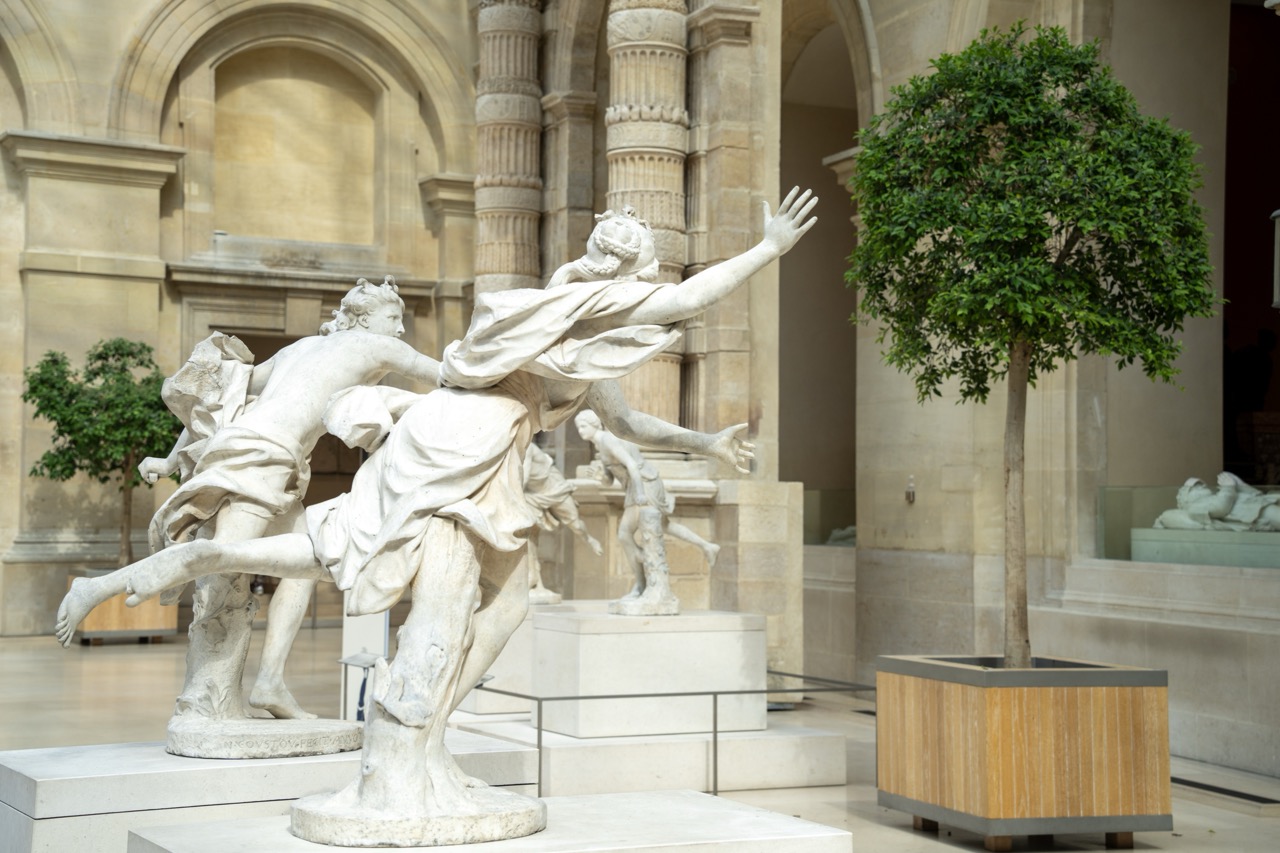

Title: The Marble Marathon
Subject Rating: 9/10
This captivating image captures a dramatic moment frozen in time, featuring a cluster of magnificent white marble sculptures in a grand museum hall. The central figure, a woman in flowing drapery, is depicted in mid-stride, her left leg extended behind her and her right arm dramatically outstretched as if reaching for something or fleeing. Her dynamic pose suggests intense motion and urgency, while the figure behind her is also caught in a powerful stride, their limbs intertwined in the action. In the background, more blurred statues hint at a larger scene unfolding. Two potted trees, one small on the left and a larger one in a modern wooden planter on the right, stand as silent, leafy observers to the marble drama. The overall mood is one of classical dynamism within a stately, quiet environment, blending ancient art with the present-day setting of its display. The background reveals towering stone pillars and arched doorways, suggesting a historical or museum building of significant scale and architecture.
From a photographic perspective, the composition places the main figures slightly off-center, leading the viewer's eye into the scene's action. The shallow depth of field effectively isolates the primary subjects while providing context with the blurred background statues and architecture. The lighting is soft and diffuse, characteristic of museum interiors, which gently illuminates the smooth marble surfaces and highlights the intricate carving details without harsh shadows. While this natural light preserves the purity of the white marble, a photographer seeking more dramatic impact might lament the lack of stronger directional light to enhance the sculptures' three-dimensionality and create more dynamic shadows that match the figures' energy. The color palette is muted, dominated by the white of the marble and the beige of the stone architecture, with only the vibrant green of the trees providing a subtle splash of contrasting color. The style is documentary, focusing on presenting the art within its environment, though the framing and focus add an artistic interpretation to the scene. The juxtaposition of the classical sculptures and the modern planter box is a small, perhaps unintentional, nod to the passage of time and the ongoing effort to preserve and display history. It's like the statues are staging a dramatic escape rehearsal, and the trees are just thinking, "Again with the running?"
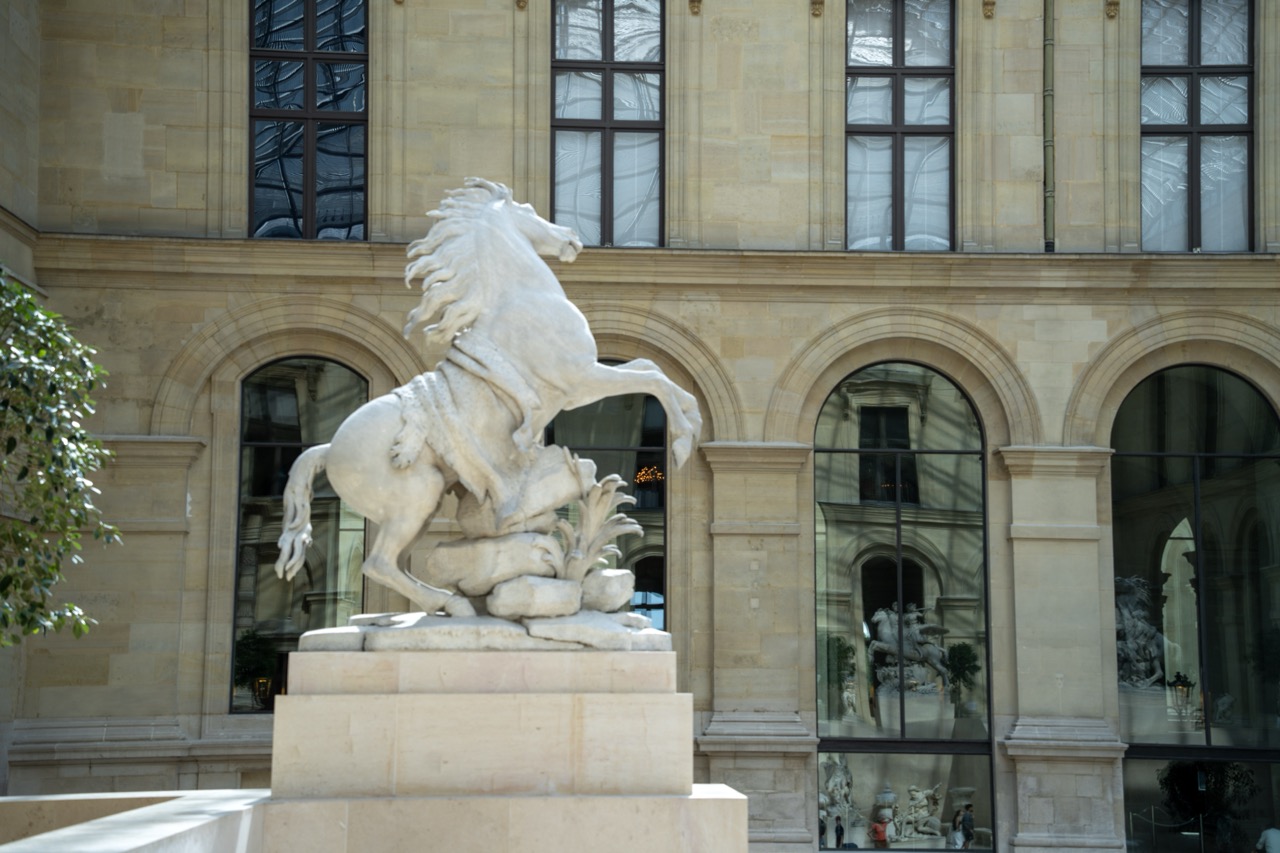

The Rearing Stallion at the Palais
Rating: Subject: 8/10
Well, here we have a magnificent white marble (or stone) stallion, giving its best "Look at me, I'm dynamic!" pose, rearing up dramatically on a pile of rocky rubble. It's a classic subject, powerful and full of energy, frozen in time. The sculptor clearly wasn't messing around – this horse is *intense*. Behind our equine friend stands a grand, light-colored stone building, looking very official and historical, possibly a palace or museum. The lower level features large arched windows, acting like funhouse mirrors reflecting the courtyard and maybe even some poor souls wandering inside. The upper windows are more reserved, framed in dark wood, giving a sense of stately repetition. The overall mood is one of classical grandeur and imposing architecture, slightly softened by the natural light.
From a photographic perspective, the composition places the dramatic horse squarely in the center, which is a safe, albeit sometimes predictable, choice. The building forms a solid, geometric backdrop, its strong lines contrasting nicely with the organic chaos of the rearing horse and its base. The tree branch on the left is trying its best to sneak into the frame – subtle, but noticeable. The lighting is rather flat and even, suggesting overcast conditions or perhaps being shot in shade. This keeps everything visible but doesn't offer much in the way of dramatic highlights or shadows, making the scene a bit... beige, light-wise. The reflections in those lower windows are quite interesting, adding layers and showing glimpses of what's inside, almost like the building is trying to spill its secrets. It's a competent shot that captures the scale and setting, though perhaps lacking a certain 'pop' due to the flat light.
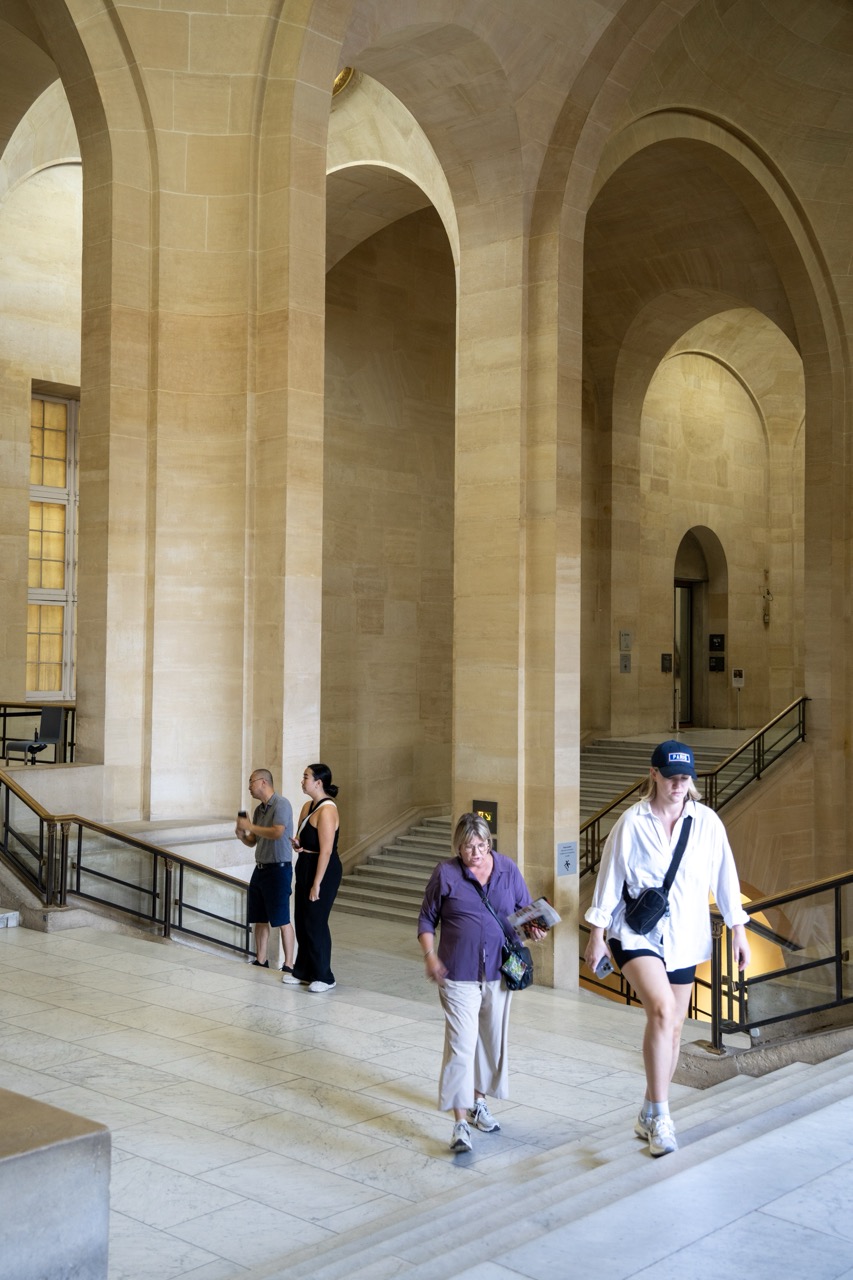

Grand Arches and Wandering Souls
Rating: 7/10
"Grand Arches and Wandering Souls" certainly captures the essence of this shot, a solid 7/10 in the 'making large spaces feel large' category. What we have here is a classic architectural scene where the building is the star, and the humans are merely supporting actors, giving scale to the monumental stone arches and columns. It feels like a quiet moment in a grand public building – perhaps a museum or a library – where people are just passing through, either contemplating the space or maybe just trying to find the nearest exit. The mood is serene, almost reverent due to the architecture, but punctuated by the mundane reality of people checking phones and navigating stairs.
Compositionally, this shot plays with symmetry and leading lines effectively. The repeated arches draw the eye back into the depth of the building, while the stairs and railing in the foreground act as a nice lead-in. The window on the left provides a compositional anchor and hints at the light source, which is pleasantly soft and highlights the texture of the stone – no harsh shadows here, which is great for showing off those lovely quarried blocks. The color palette is dominated by the warm stone, making the people's clothing stand out a bit, like splashes of temporary color in an ancient, unchanging space. It's a competent capture of a challenging interior space, showing off the scale and detail without getting too lost in the shadows. My only critique? Maybe ask the woman in purple if she needs directions, she looks a bit lost in contemplation... or maybe just trying to figure out her map.
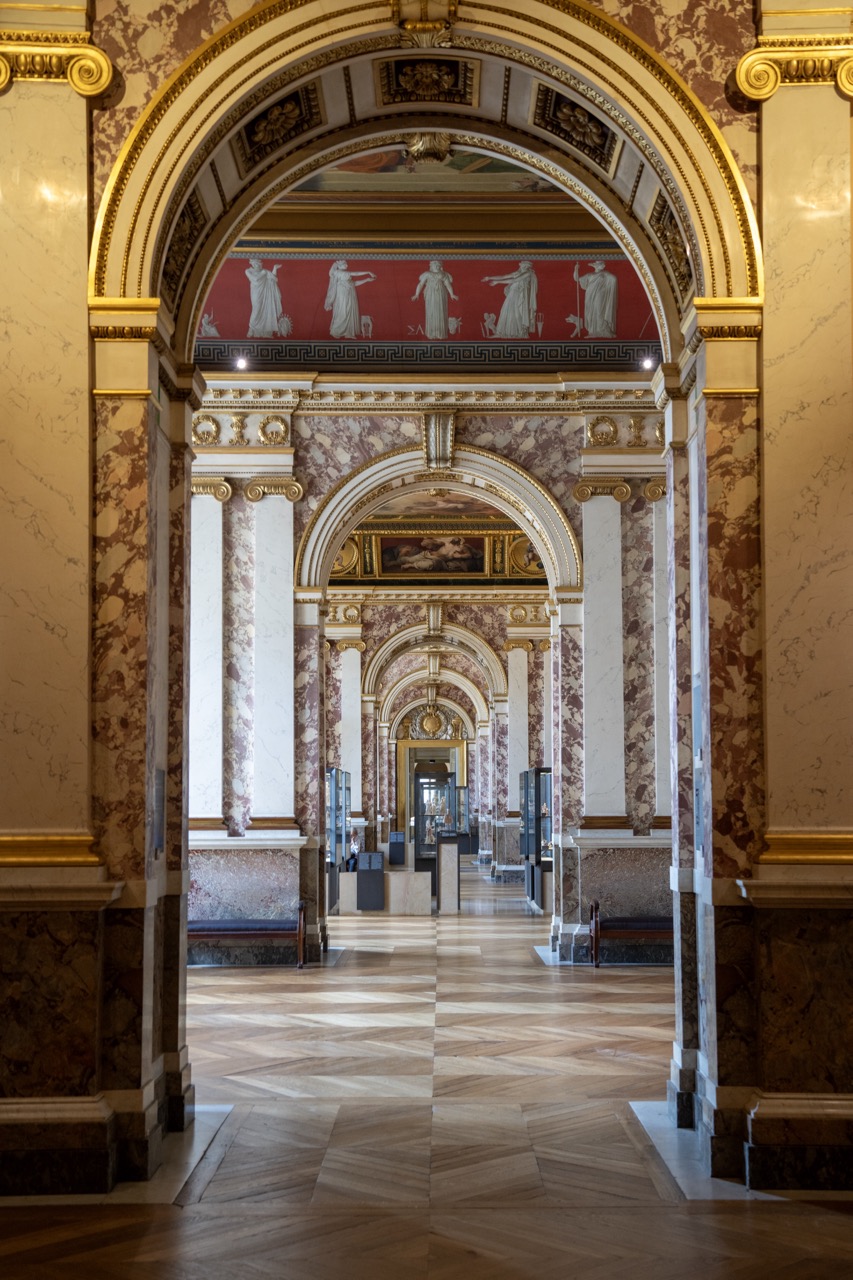

Hall of Infinite Arches and Questionable Dusting Habits
Rating: 8.5/10
Step right up to the grand parade of arches! This shot perfectly captures the overwhelming opulence of what appears to be a museum or grand hall, making you feel simultaneously tiny and ridiculously fancy. The composition is a textbook example of using leading lines and symmetry to create depth, drawing your eye down the seemingly endless tunnel of marble and gold. It's like an architectural matryoshka doll, with each arch framing the next, promising ever more historical goodies (or just more arches, let's be honest) in the distance. The mood is undeniably majestic and perhaps a touch intimidating – this is where important things clearly happen, probably involving velvet ropes and hushed tones. There are benches lining the sides, offering a momentary respite from the visual onslaught, while glass display cases in the background hint at treasures waiting to be discovered deeper within.
The lighting is rather pleasant, softly illuminating the richly veined marble and making the gold trim pop without resorting to harsh shadows, which is a win for showcasing all that intricate detail. The color palette is warm and classic, dominated by the reddish-brown and white marble, accented by the striking red frieze above the first arch with its classical figures (who look like they're silently judging your selfie skills). The patterned wooden floor, laid out in contrasting squares of herringbone, adds another layer of visual interest and provides a nice counterpoint to the vertical grandeur. This is prime architectural photography, capturing the scale and decorative intensity, likely a challenging shot to get perfectly centered without any wandering tourists photobombing the scene (a photographer's eternal struggle). The only major critique? One can only imagine the sheer amount of dusting required in this place.
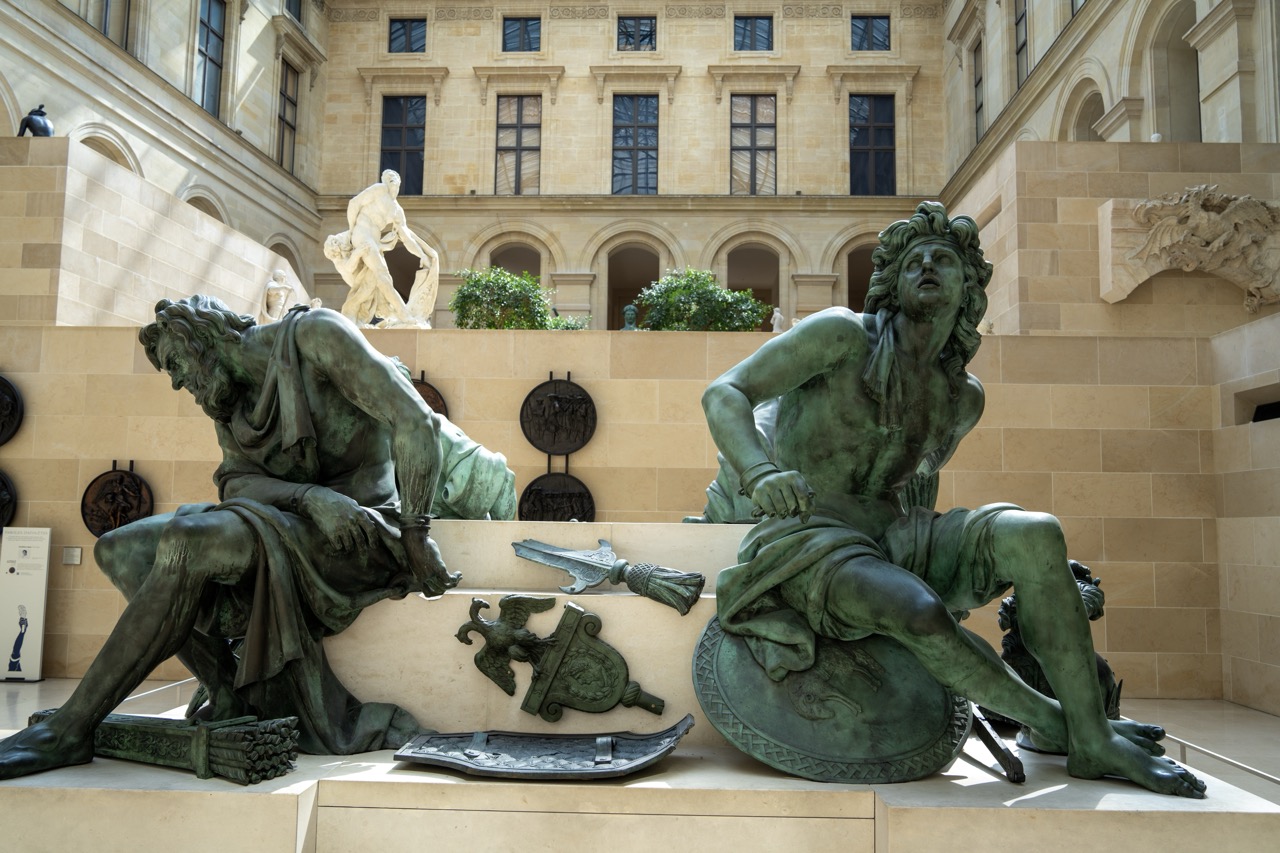

Weary Titans and Scattered Souvenirs
Subject Rating: 8/10
Ah, the dramatic tableau of two very large, very green gentlemen looking utterly spent, surrounded by their discarded gear. What we have here are magnificent bronze statues, one hunched in what looks like profound existential despair or perhaps just a really bad cramp, and the other leaning forward, maybe just trying to catch his breath after a vigorous session of... something involving shields and pointy things. Scattered at their feet are the remnants of their efforts: a bundle of sticks (always handy?), a shield with an eagle that looks vaguely annoyed, a sword, and another decorative piece. The mood is decidedly heavy and historical, like finding ancient warriors mid-breakdown. It feels weighty and monumental, like a scene from a very long, possibly boring, epic poem. You can almost hear the bronze groaning.
From a photographic standpoint, this shot is a masterclass in capturing drama and scale. The low angle emphasizes the sheer size of these sculptures, making us feel small and slightly intimidated, which is probably the point. The composition expertly frames the central chaos of discarded objects between the two figures, leading the eye nicely through the scene. The natural light filtering in beautifully highlights the textures of the bronze patina and the rough stone, though balancing the exposure between the dark statues and the bright background must have been a bit of a juggling act – props to the photographer for not blowing out the sky (or lack thereof, in this case, an inner courtyard). The warm stone background provides a lovely contrast to the cool, verdigris green, adding depth and context with its arches, windows, and other white statues looking down from their perches, perhaps judging the messy state of affairs below. It's a compelling image that makes you wonder about the story behind these weary bronze warriors.
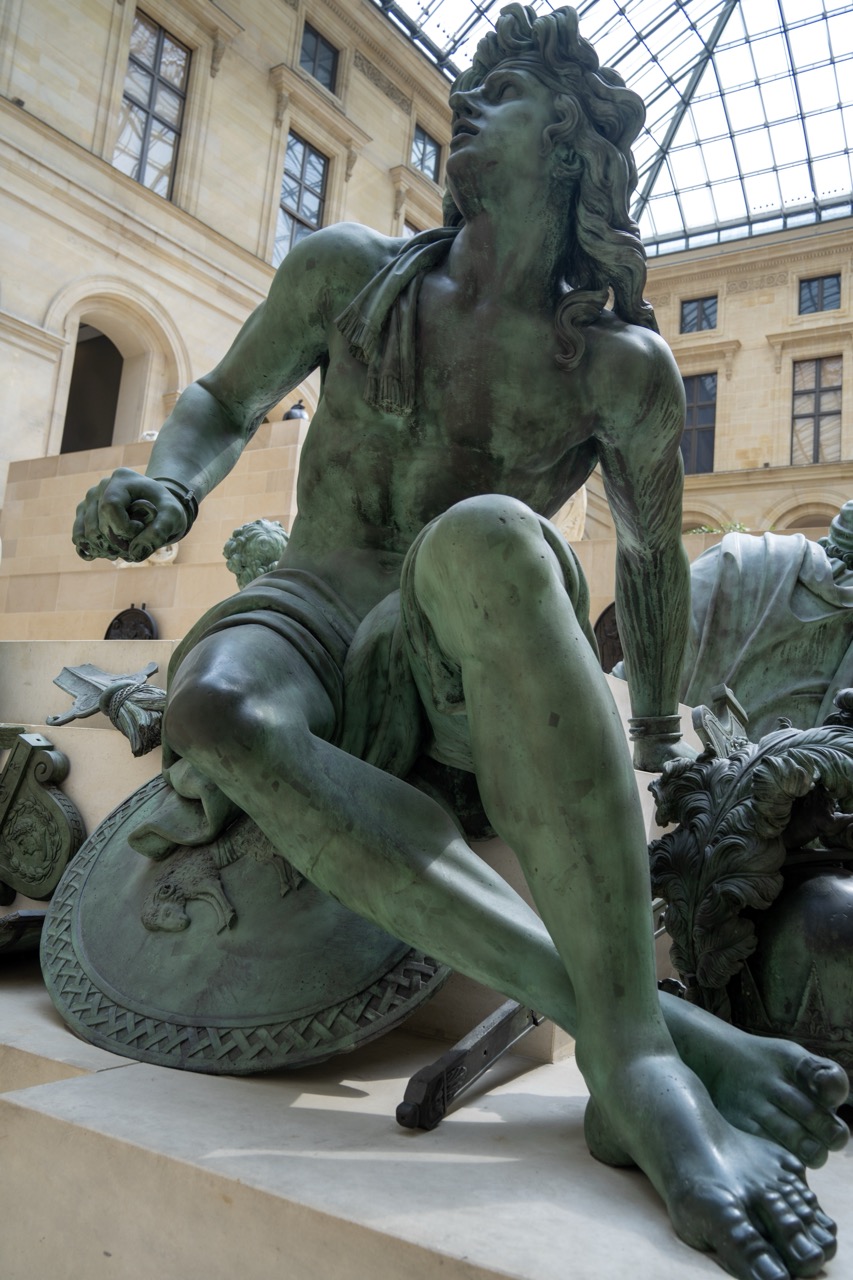

Okay, behold the seated hunky bronze dude, a solid 8/10 on the 'Ancient Sculpture Swag' scale. He's caught mid-pose, looking intensely upwards, perhaps contemplating the meaning of life, or maybe just admiring the impressive glass ceiling above while taking a load off. Flanked by a detailed shield sporting some fierce beast (an eagle? a griffon?) and a hint of weaponry, he embodies a quiet power, the kind that says "I could totally go fight a monster right now, but honestly, this plinth is comfy." The mood here is definitely 'Epic Hero on a Coffee Break,' resting but still radiating readiness, all set within the majestic, sun-dappled grandeur of what looks suspiciously like a very fancy museum hall with its classical architecture and expansive skylight.
From a photography standpoint, the low angle is a smart move, really emphasizing the statue's scale and muscle mass – because who doesn't love heroic bronze captured from a worm's-eye view? The composition is strong, using the diagonal of the leg and the curves of the body to lead the eye upwards. The lighting, filtered through that magnificent glass roof, is beautifully soft and diffused, which is great for showing detail in the bronze patina, though it results in somewhat flat illumination. A touch more side light could have added dramatic contours. The color palette is dominated by the cool green of the bronze set against the warm stone of the building, creating a classic, timeless look. Overall, a well-executed shot that captures the imposing nature of the subject and the impressive setting, making you feel tiny next to this ancient dude just chillin'.
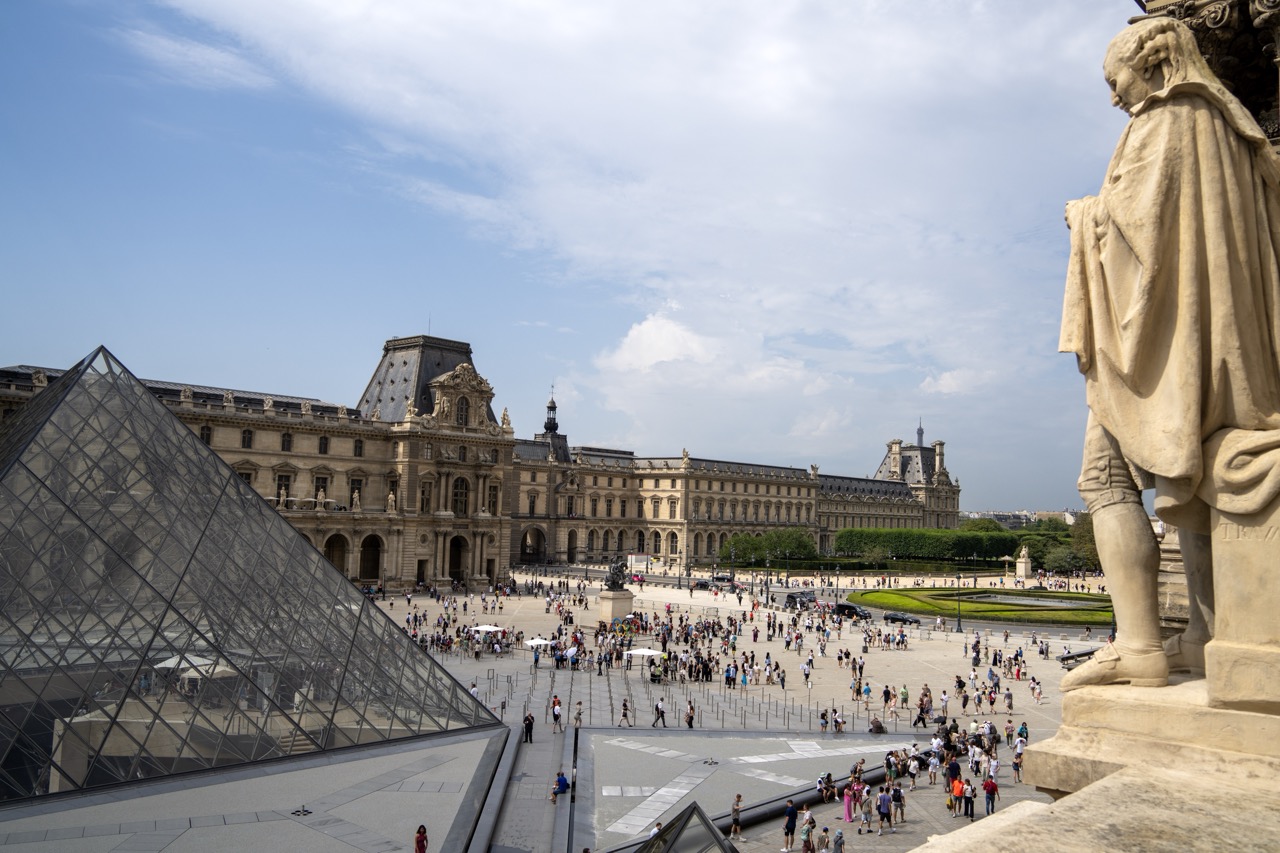

Title: Pyramid, Palace, and the Parisian Shuffle
Rating: 7/10
Ah, the Louvre. A place where history and geometry collide, usually accompanied by a level of human density rivaling rush hour on the Tokyo subway. This image captures that quintessential scene: the magnificent, sprawling palace standing stoically behind I.M. Pei's iconic glass pyramid. Look closely, and you'll see the vast courtyard transformed into a sea of tourists, all engaged in the universal pilgrimage to soak in culture (or just get that perfect Instagram shot). The mood is undeniably bustling and energetic, a testament to the enduring appeal of this Parisian landmark, even if navigating it feels like a real-life game of Frogger. Off to the right, a stone statue stands sentinel, seemingly observing the modern-day spectacle with ancient indifference, while the distant silhouette of the Eiffel Tower peeks over the treetops, a reminder that you're definitely in Paris and likely surrounded by people wondering where the Mona Lisa is (it's inside, folks!).
From a photographic standpoint, the composition gives us a decent overview, balancing the prominent foreground pyramid on the left with the grand palace stretching across the background. The statue on the right adds a sense of depth and a bit of framing, though its partial inclusion is a slight distraction. The lighting is typical for an overcast or slightly hazy day, providing soft, even light that avoids harsh shadows but doesn't offer much dramatic flair – perhaps a silver lining for detail rendition in the busy scene. The color palette is muted, dominated by the stone of the buildings and the grey of the pavement, fitting the historical setting. It's a classic documentary style shot, effectively conveying the scale and activity of the Louvre's courtyard. While it's not a groundbreaking perspective, it accurately depicts the vibrant, slightly overwhelming reality of visiting one of the world's most famous museums on a busy day.